#dark nights death metal (2020)
Explore tagged Tumblr posts
Text
barbara gordon in dark nights death metal: the last stories of the dc universe (we fight for love)
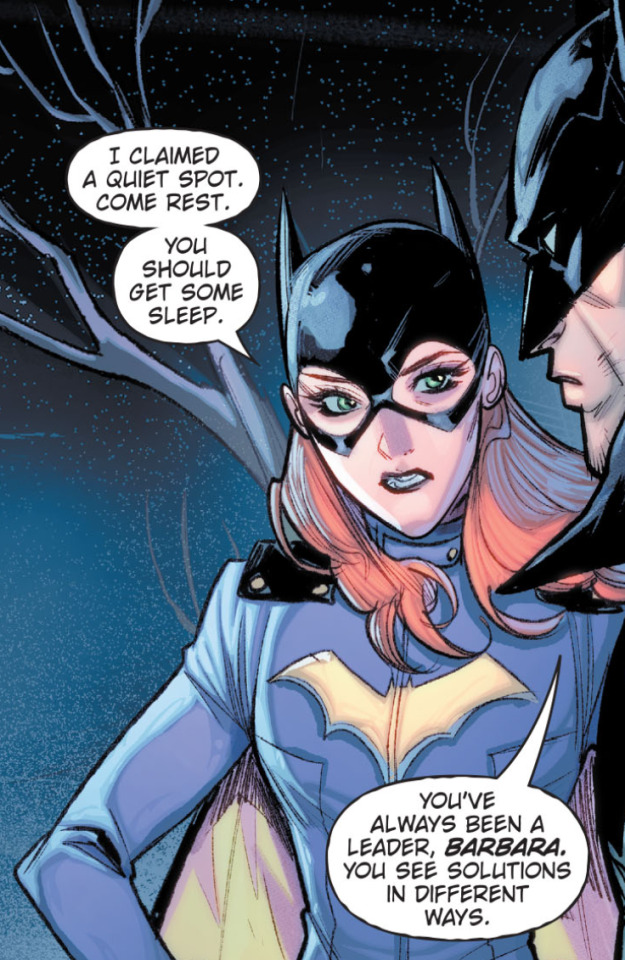
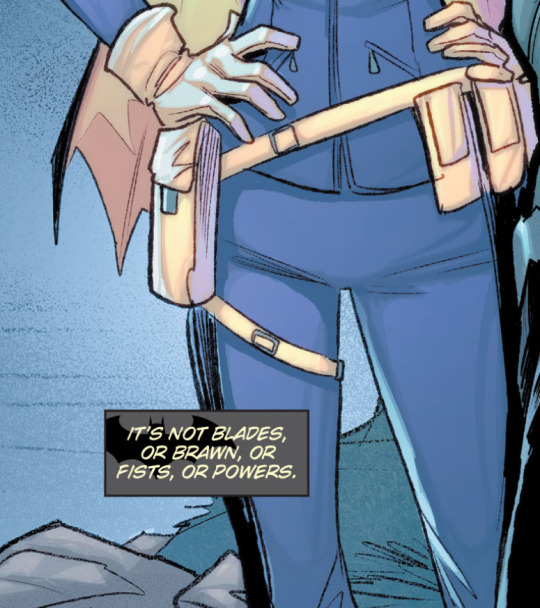
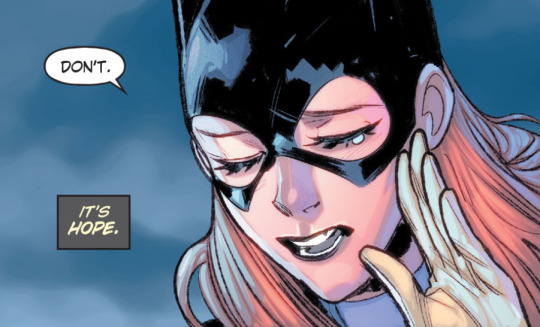
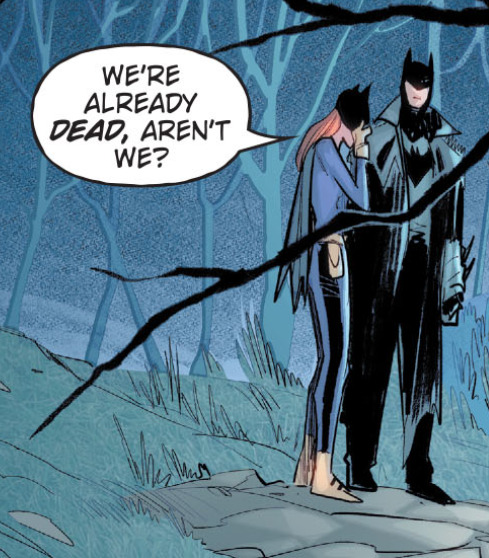

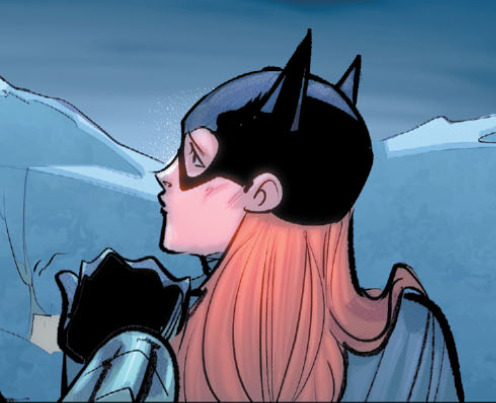




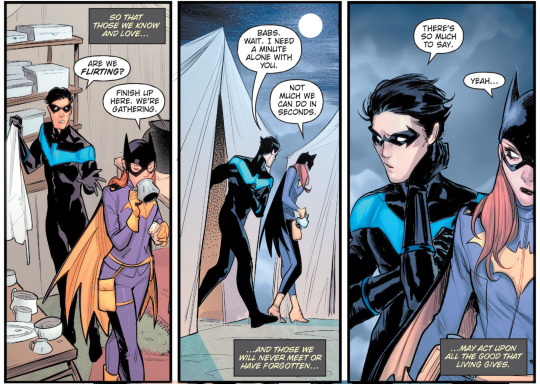
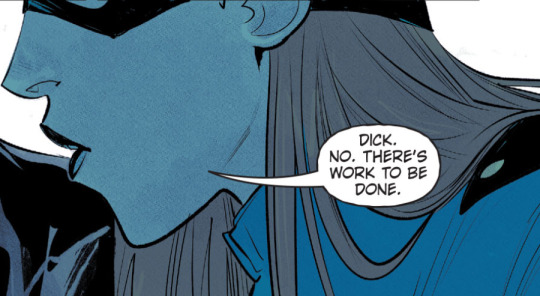

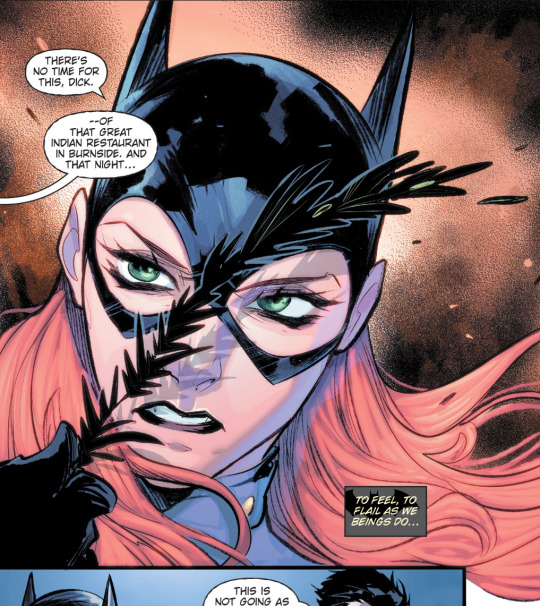



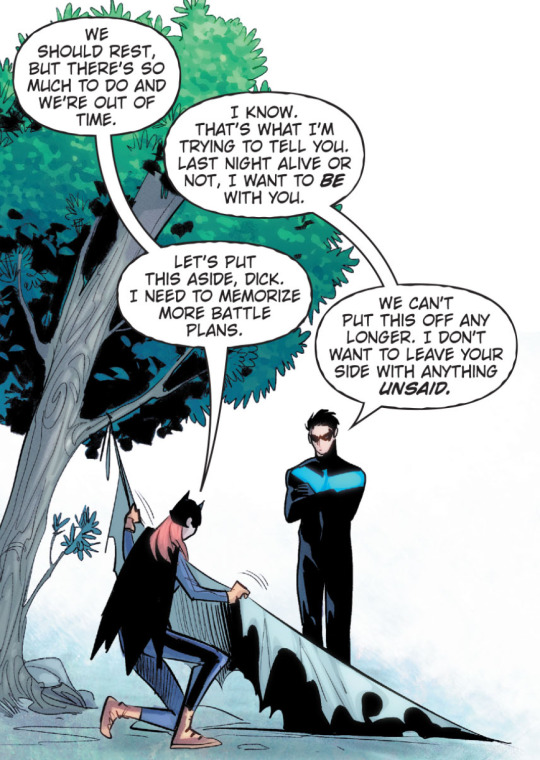

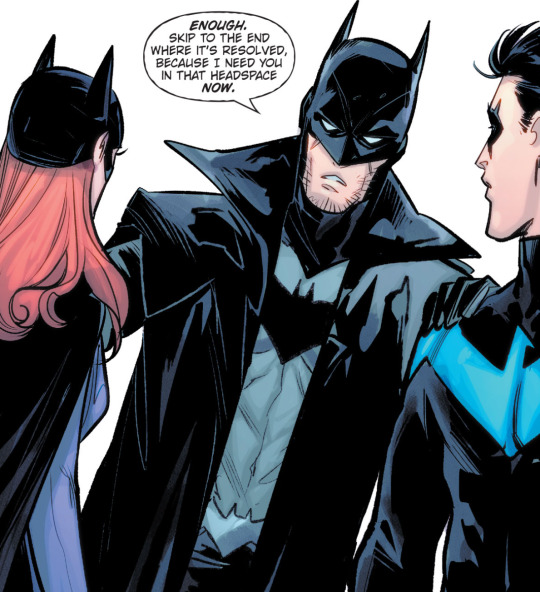
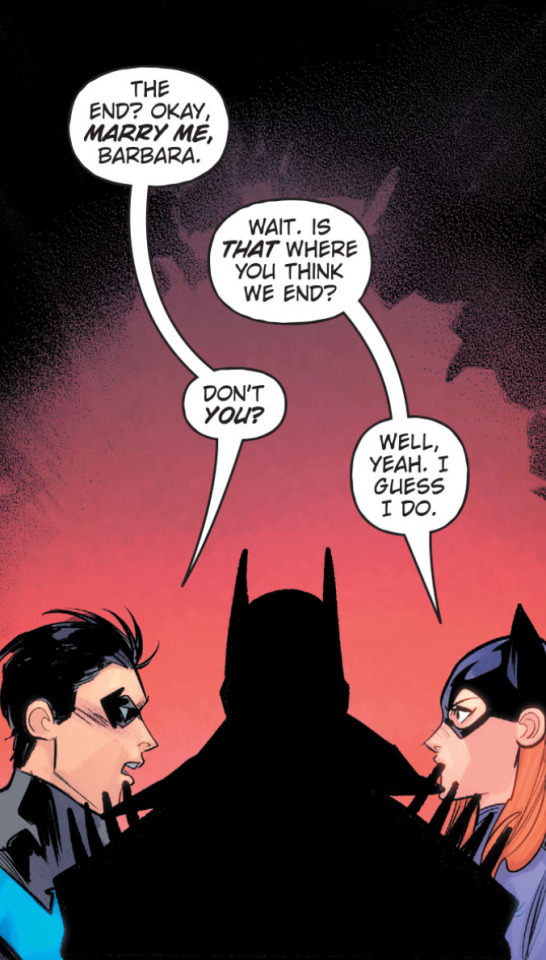
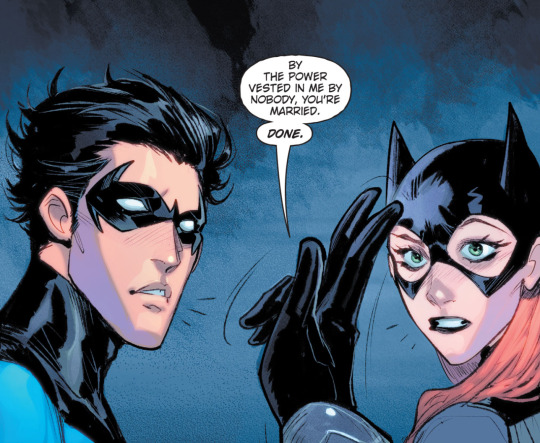
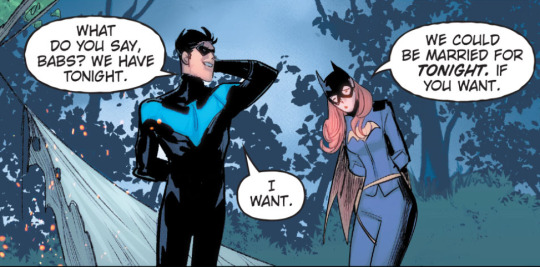

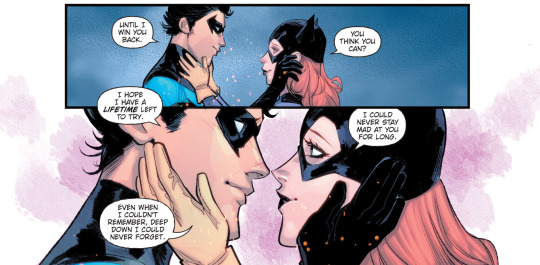

bonus:

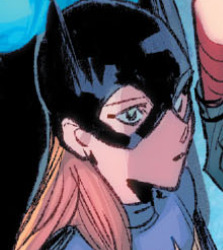

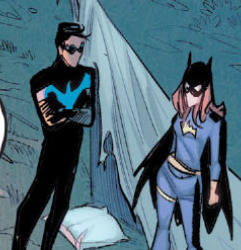
#missing a few little babses in panels where she doesn't speak#but overall#this is her in this#reading this makes me so infuriated with rebirth batgirl though#like she actually has nuance here meanwhile in rebirth batgirl it's like a slogggg to read through#recently re-read the summer of lies arc for dickbabs and it reminded me of just how bad i hate rebirth batgirl#anyways#barbara gordon#batgirl#dick grayson#nightwing#dickbabs#bruce wayne#batman#jason todd#red hood#tim drake#damian wayne#robin#dc comics#comic panels#dark nights death metal (2020)#the last stories of the dc universe#written by: cecil castelluci#art by: mirka andolfo#colours by: andrew dalhouse#queue#sorry for so much babsgirl lately#but going to start the bop arc soon so i'll try to more from that soon
90 notes
·
View notes
Text






Dark Nights: Death Metal (2020) cover art by Greg Capullo
#diana prince#clark kent#bruce wayne#dc comics#batman#superman#wonder woman#trinity#superwonderbat#dc#cover art#greg capullo#harley quinn#martian manhunter#superboy prime#green lantern#the flash#dark nights death metal#cover edit#diana of themyscira#kal el#comics#still one of my fave events
90 notes
·
View notes
Text
Jon Kent (pretty much) Complete Reading Order
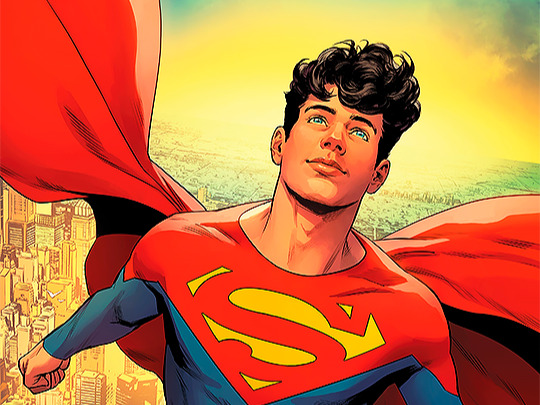
Compiled first for my personal use and tidied up for @jonkentweek ! Goes up to June 2024 and includes every appearance of this character that I could find. I used ComicVine's archive to track these down, which is both fallible and constantly being updated, so there might be some mistakes. Also, I did my best to highlight the occasions where Jon was a significant character in a story and to skip the ones that were just a non-speaking, one-panel cameo, but those were personal judgements and your mileage might vary.
Color key (and apologies for the eye strain): Red are issues in which Jon is a central character, not just a cameo, Blue are crossover events, Orange are stories that take place in alternate universes/are non canonical
Optional stuff you can read for historical context:
Whatever Happened to the Man of Tomorrow? (1997) a classic possible future story, which is, to my knowledge, the 1st time a character named Jon who is Superman’s kid appears
Son of Superman (1999) a self-contained, now AU, story about a teen Jon Kent, very classic 90s young adult comic with all the tropes that come with that, but enjoyable as the proto-iteration of Jon as an idea
Canon appearances start here
The Final Days of Superman crossover event: Superman (2011) 51-52, Batman/Superman (2013) 31-32, Action Comics (2011) 51-52, Superman/Wonder Woman (2013) 28-29 (This is the origin story of the Clark, Lois and Jon that the comics follow in Rebirth. Largely ignored by writers, as it was written to patch up New52 weirdness, but there are occasional references that might be confusing if you skip it completely.)
Convergence (2015) 5, 8
Superman: Lois and Clark (2015) 1-8 (Establishes Jon and his family in the DCU)
Superman (2016) 1-11, 13, 17-28, 30, 32-36, 38, 40-45, Special 1
Action Comics (2016) 957-972, 974-978, 980-983, 985, 987, 989-1000, 1002, 1005, 1016, 1022-1035, 1042, 1045-1048, 1050-1057, 1059-1060, Special 1, Annual 2023
Justice League (2016) 3-6, 15, 18-19, 22, 28
Trinity (2016) 1-6, 16
Super Sons (2017) 1-16
Dark Nights: Metal (2017) 3, 6
The Man of Steel (2018) 1-6 (central from issue 4 onwards)
Superman (2018) 1, 4-12, 14-16, 20, 29-32
Adventures of the Super Sons (2018) 1-12
Justice League (2018) 9, 23-25, 34, 52, 75, Annual 2022
Super Sons/Dynomutt Special (2018)
Super Sons: The Polarshield Project (AU trilogy of graphic novels)
Supergirl (2016) 8, 30-33
DCeased (2019) 1-6 (what if DC but zombies?)
Super Sons: The Foxglove Mission
Lois Lane (2019) 3-4, 6
Legion of Super-Heroes: Millennium 2
Legion of Super-Heroes (2019) 1-12
Dark Knight Returns: The Golden Child
Green Lantern: Blackstars 2-3
The Terrifics (2018) 25
Teen Titans (2016) 15, 43, 45-46
DCeased: Hope at World’s End (2020) 1, 4-5, 9-15
Robin 80th Anniversary 100-Page Super Spectacular (in the short Super Sons story)
DCeased: Dead Planet (2020) 1-7
Super Sons: Escape to Landis
Batman/Superman (2019) Annual 1
Challenge of the Super Sons (2020) 1-14
Dark Knights: Death Metal The Last Stories of the DC Universe (2020) (in the Superman short story)
Dark Knights: Death Metal The Secret Origin (2021)
Dark Knights: Death Metal The Last 52 War of the Multiverses (2021) (in the Superman parts of the story)
DC Nation Presents Future State (2020) (intro, information and behind-the-scenes for Future State)
Future State: Superman of Metropolis (2021) 1-2 (Future State is another possible future, meaning that it’s not necessarily canon, but it takes place in the future of the main canon, not in a complete AU, like say, Dark Knights of Steel. Technically not necessary to understand main universe stories, but a few popular characters and characterizations were brought over to the main universe.)
Future State: Justice League (2021) 1-2
Future State: Superman/Wonder Woman (2021) 1-2
Future State: Kara Zor-el, Superwoman (2021) 1
Future State: Legion of Super-Heroes (2021) 2
Infinite Frontier (2021) 0 (establishes the main universe status quo from this point on, feat. a synopsis of Jon’s life up to here)
Challenge of the Super Sons (2021) 1-7
Superman: Son of Kal-el (2021) 1-18, Annual 1
Shazam! (2021) 1
Superman Red and Blue (2021) 6 (in the short story The Special, but this mini series in general is cute and I recommend it)
Justice League vs. The Legion of Super-Heroes (2022) 1-6
Superman & Robin Special (2022) 1
DC’s Round Robin (2021) 2 (in the short story Superboy: The Man of Tomorrow)
Nightwing (2016) 89, 91-92, 101-104, 110, 112-113
Earth-Prime (2022) 2 (story based on the CW show Superman and Lois)
DC Pride (2022) (in the short story Super Pride)
Justice League: Road to Dark Crisis (2022) (in the short story Team Up)
Dark Crisis (2022) 1-7
Dark Crisis: Young Justice (2022) 1
Dark Crisis: Worlds Without A Justice League: Superman (2022) 1
DCeased: War of the Undead Gods (2022) 1, 4-5, 7-8
DC’s Terrors Through Time (2022) (in the short story Trick or Treat)
Dark Crisis: The Deadly Green (2022) 1
The Death of Superman 30th Anniversary Special (2023) (in The Life of Superman short story)
Dark Crisis: The Dark Army (2023)
Superman: Kal-El Returns Special (2023) (in the short story Distractions)
Lazarus Planet: Assault on Krypton (2023) (in the short story Electric)
Batman (2016) 131-132 (in the Tim Drake Robin chapters)
Superman (2023) 2-3, 9
Lazarus Planet: Omega (2023)
Power Girl Special (2023)
Adventures of Superman: Jon Kent (2023) 1-6
Superboy: The Man of Tomorrow (2023) 1 (edited version of the story in Round Robin)
DC Pride (2023) (in the short story My Best Bet)
Titans: Beast World (2024) 3-4, 6
Titans: Beast World Tour: Metropolis (2024)
Trinity Special (2024) (taken from the backups of Wonder Woman 2023 plus some extra)
#*drags myself across the finish line* its done#hope it comes in handy ☺#feel free to correct me if something is wrong#dc comics#superman#superboy#jon kent#jonathan kent#superfam#super sons#reading order#reading list#reading guide#long post
83 notes
·
View notes
Text
Unexpected Goth music
In the 90s you had the curious dilemma of both trying to avoid the title of Goth and also being accepted in the perceived Goth community. And there was an unfortunately high number of gatekeepers. You'd get asked what your favorite Goth artist or song was and for whatever reason "That doesn't count." or "That's actually Punk." or 'That's Death Rock, not Goth." or "That's too mainstream, that's not REAL Goth." And it got very irritating. So I'm going to list some of the things I think fit under the Goth genre that many would either not consider at all or would think "don't count." Disclaimer: This list does not contain obvious bands like The Cure, Siouxsie and the banshees, or Bauhaus. Once you remove those you'd be surprised how limited the selection of "real" Goth starts to feel. ______________________ And now here are the things that have (in my own experience) been classified as not Goth despite really fitting the criteria. Aurelio Voltaire - Sometimes considered Goth folk or "Dark Cabaret" or even "Death Rock" (1988 version of The Night) Aurelio Voltaire pretty much personifies Goth music. From his Gothic Neo Victorian / pirate look to such songs as Raised by Bats, Land of the Dead, Vampire Club, and the Neil Gaiman's The Sandman inspired "Come Sweet Death." Aurelio Voltaire is so Goth that I can't help but think there are other reasons people may not want to count him such as unconscious racism. (He's Cuban and has released Spanish language tracks.) Danny Elfman - Perhaps today most well known for his movie scores, particularly the iconically Gothic Nightmare before Christmas (where he was multiple voices including Jack's singing voice), Danny Elfman used to be the front man for the band Oingo Boingo where he had such songs as Dead Man's Party, Flesh 'n blood, Weird Science, No one lives forever, and No Spill Blood. These are arguably Gothic themed but not Gothic "style." However I do feel there is some Goth leanings in his 2020 album Big Mess which was officially released as the genre Industrial Goth. The Hex Girls - This band was invented for the 1999 Scooby Doo animated movie, Scooby Doo and the Witch's Ghost. Representing Gothic fashion, Wiccan spiritual beliefs, and environmentalism the band was meant to be a Gothic inversion on The Spice Girls. Defined as "Eco Goth" though arguably pop their songs actually were really good including "Earth, Wind, Fire, and Air" (though admittedy it should be Earth, Water, Fire, and Air), The Witch's Ghost, and Hex Girl. Inkubus Sukkubus - Considered Pagan Rock, they are definitely Goth, including the songs Sweet Morpheus and Vampire Queen (and several other vampire themed songs!) Blackmore's night - Neo Medieval folk rock band. You know... I think once you get called "Neo Medieval" you get a free pass to call yourself Goth. That's just my opinion. Including the songs Locked Within the Crystal Ball, The Darkness, and Shadow of the Moon.
Within Temptation - Symphonic Metal / Gothic Metal. One question... have you listened to them? Just listen to Angel, Stand my Ground, The Fear, or A Demon's Fate. Eden's Bridge - Progressive Celtic Folk Rock. They have two songs dedicated to Oscar Wilde's The Canterville Ghost. I know one song isn't enough but still... Sonata Arctica - Metal but some of their biggest hits are about magic and more commonly werewolves. Cain's offering - Again, Metal, but the subject matter is decidedly Gothic. Kamelot - Power metal but they have two albums that retell Goethe's Faust parts 1 and 2 (Epica and The black Halo). In fact pretty much everything they do is of Gothic inclination. Richard Campbell - Metal but he did an entire metal opera retelling the novel Frankenstein. I think that's pretty Goth if you ask me.
Smashing Pumpkins - Considered Alternative rock. There was time where just about anything vampire related was advertised with Bullet with Butterfly Wings. And the band is named after a popular Halloween prank. The lead singer is also a professional poet.
Alice Cooper - Welcome to my Nightmare, Keepin' Halloween Alive, The Ballad of Dwight Frye (actor from classic universal monster movies), Gimme, Black Widow (With Vincent Price). He also performed in Tim Burton's Dark Shadows.
Marilyn Manson - Once Classified as industrial Goth, he was denounced by many Goths as "too mainstream" or "Not Goth enough." The man did covers of Danny Elfman's This is Halloween, David Bowie's Golden Years, Annie Lennox's Sweet Dreams, and Lost Boys' Cry Little Sister. That's pretty Goth if you ask me. My Chemical Romance (MCR) - Do I really need to elaborate wit this one? David Bowie - Mostly considered Glam Rock, Bowie has dabbled in all genres and Heart's Filthy Lesson was definitely industrial. Aurelio Voltaire did a Goth sequel to the songs Bowie wrote for Labyrinth. And Bowie's Scary Monsters and Super Creeps inspired Danny Elfman. You can't get more Goth than that (In my opinion). Even Bowie's album Hours drifts into Emo territory. Prince - At the very least he had a Goth aesthetic. I think if he wasn't black people would be quicker to realize he could fit as Goth. There's a lot of unconscious racism among some (not all) Goths. Michael Jackson - One word. Thriller. He also had The Boogeyman's Gonna Get ya with The Jackson Five, and later Ghost. But once you get Vincent Price to rap you should automatically count. The Rasmus - Rock but most of their songs are decidedly Goth and probably should count such as In the Shadows, Ghost of love, and Lucifer's Angel. Sarah McLachlan - Though considered pop let's be honest. Every Goth and person in the 90s "vampire Scene" had her Surfacing album or at least heard Building a Mystery. Before her music started playing in ASPCA commercials you heard songs like Adia on Buffy The Vampire Slayer. Savage Garden - Though definitely pop they get an honorary mention for having songs inspired by Anne Rice and for naming themselves after a phrase invented by The vampire Lestat to describe the nature of the world in The Vampire Lestat novel by Anne Rice. Sting - Though not always Goth, Sting was in the Gothic horror movie The Bride and wrote a song from the perspective of Louis in Interview with the vampire called Moon over Bourbon Street. Stevie Nicks - She got an American Horror story: Coven tie-in music video and practices witchcraft. That's like hitting a Goth bullseye. Johnny Cash - Wore all black all the time and did a cover of a NIN song that is considered better than the original version, Hurt. Sir Elton John - Glam / Pop rock but he gets an honorary mention for composing the Lestat Broadway musical and having a full demo album that was never officially released and can only be found through dubious / underground sources. (Or Ebay if you were lucky in 2006...) Honorable mention to Bobby "Boris" Pickett for having the first Gothic themed song to get banned in the UK (Monster Mash) for being "Too morbid." You can't get much more Goth than that.
38 notes
·
View notes
Text
Deaths of Damian Wayne
Part of the Batfam Death Project.
Damian has died six times and has once visited an afterlife without dying. There are also two additional occasions when he might arguably have died, but it’s not confirmed.
Despite the fanon idea I’ve seen that Damian was killed and raised in the Lazarus Pits once or more during his upbringing in the League of Assassins, I couldn’t find any hard evidence of this. The nearest thing I have found is a flashback scene of Ra’s holding a young Damian at swordpoint with a Lazarus Pit in the background (The Shadow/Batman 1:3, 2018). Which suggests that it was a viable threat, but I don’t think there is any indication there that it ever went further than a threat. So I didn’t include it here, even as an ambiguous/possible death. (If anyone has any better evidence that it ever actually occurred I will be happy to revise this post to include it.)
Verifiable deaths
1. Killed by his clone (Batman Incorporated 2:8, 2013)
Talia created a clone of Damian and called him The Heretic (I have never been able to discern what exactly his heresy is supposed to be), artificially aged him to adult stature (though not mind) and sent him to kill Damian for reasons of… um… to be mean to Bruce?
…Anyway, The Heretic strangled Damian, who also got shot with several crossbow bolts, and then finished him off by impaling him with a large sword.
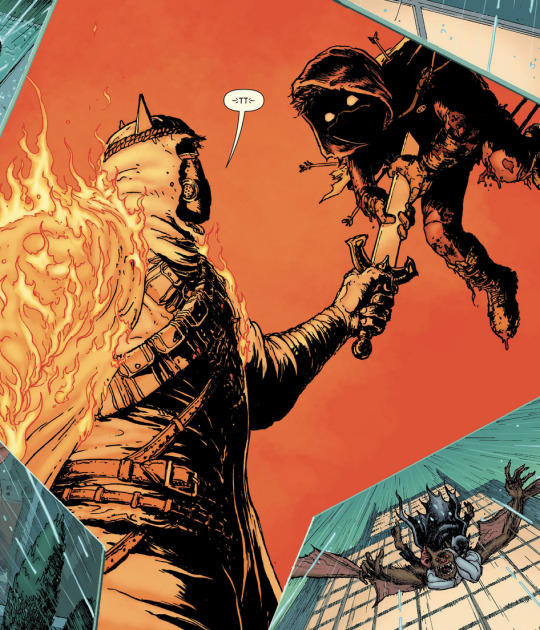
Bruce and much of his family eventually took Damian to the planet Apokalips and resurrected him by stabbing him with a chaos shard which he had taunted Darkseid into blasting with omega energy (Batman and Robin 2:37, 2015).
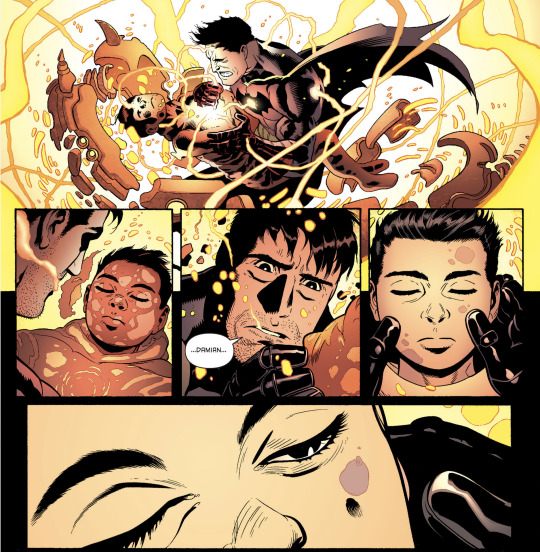
Following this he had superpowers (flight, invulnerability, super strength) for a short time (Robin Rises: Alpha, 2014).
Time dead: a few weeks to a couple of months, which time he spent in Hell (mentioned in Robin Son of Batman 1:1, 2015, and Teen Titans 6:40, 2020 – see below).
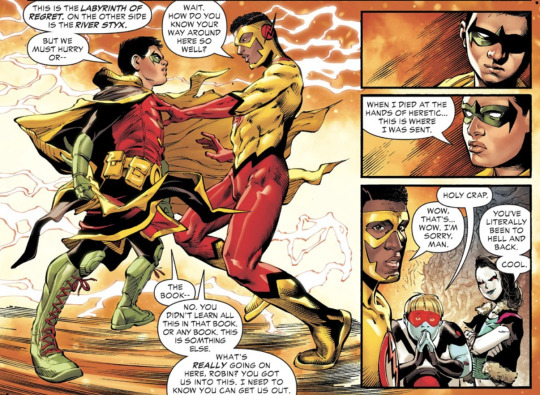
2. Shorted out a spirit battery (Robin Son of Batman 1:13, 2016)
The villain Den Darga was charging up a spirit battery, running on human souls, with the aim of killing everyone in the world to give him more power. Damian shorted out the battery, which destroyed it, released the souls, and killed him.
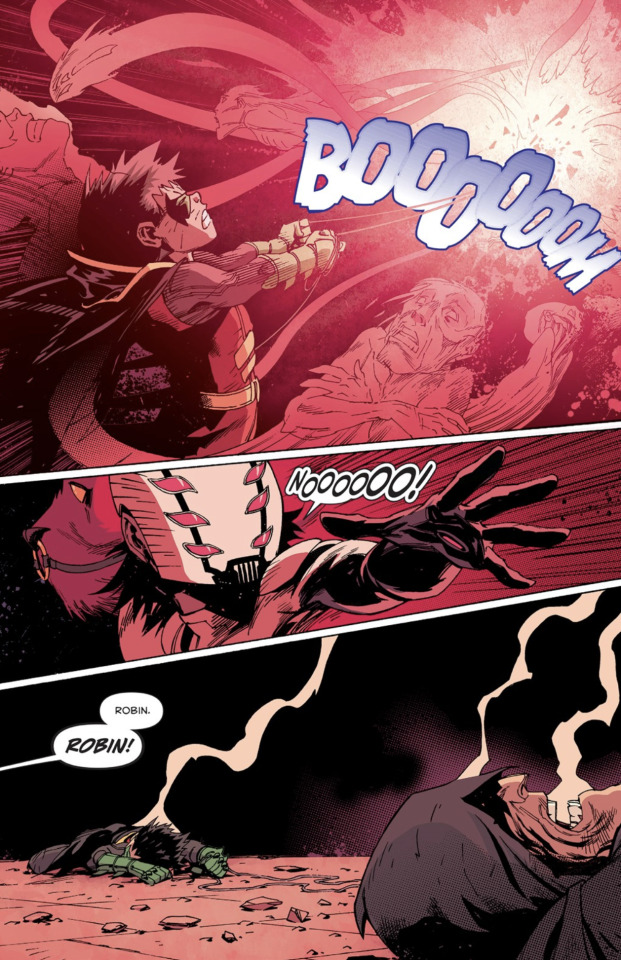
His friends Maya Ducard and Suren Darga (who is Den Darga’s son and who can see and call spirits) called his soul back into his body. It’s visually implied that this time he would have gone to Heaven.
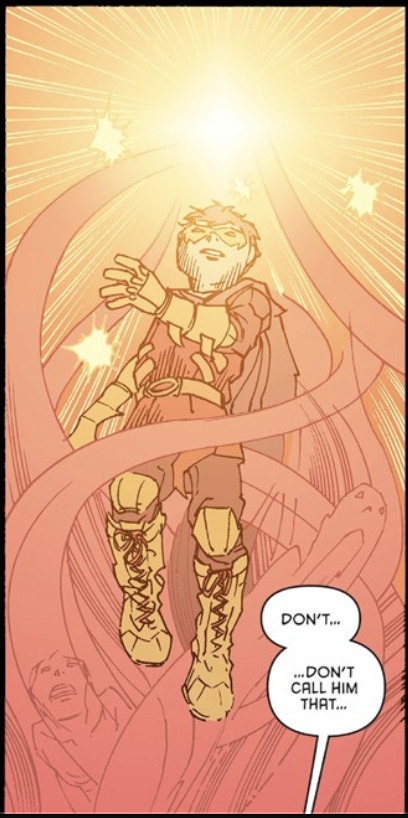
Time dead: a couple of minutes.
3. Poisoned himself – on purpose (Teen Titans 6:40–41, 2020)
When Damian was on the Teen Titans, one of his teammates, a genie going by Djinn, got trapped in Purgatory by her evil brother Elias. Damian drank poison and got the rest of the team (except one) to do the same so they could die and go to Purgatory (via Hell) to rescue her.
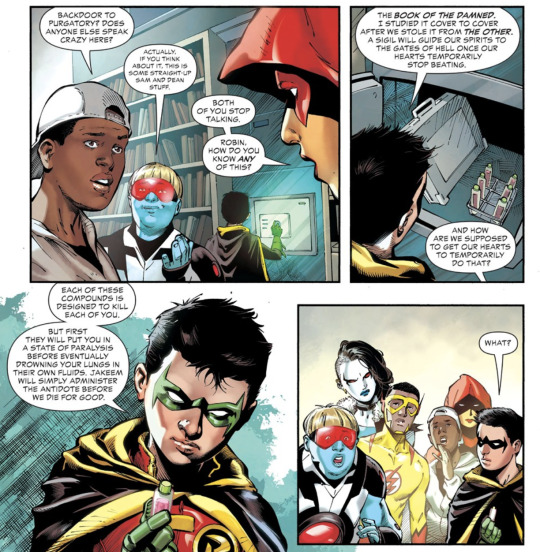
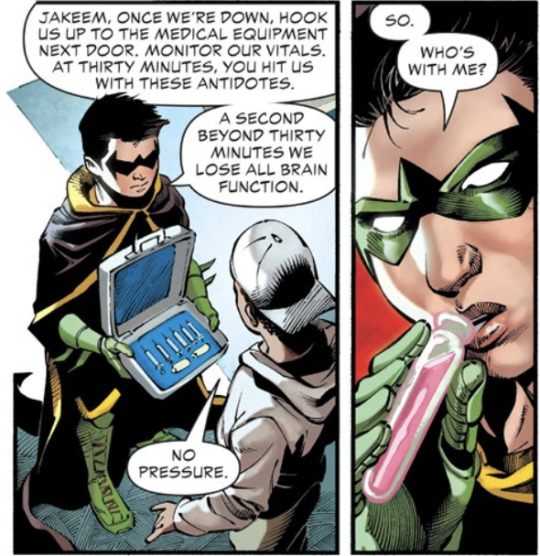
Their colleague Jakeem Thunder remained behind to watch over their bodies and resuscitate them. He first tried by normal medical means but failed. So he called on the powers of his genie friend, Thunderbolt, and all the Teen Titans were raised through a combination of Thunderbolt’s and Djinn’s powers.
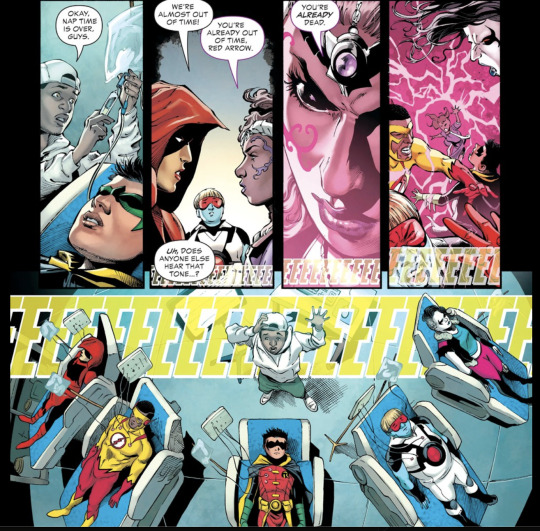
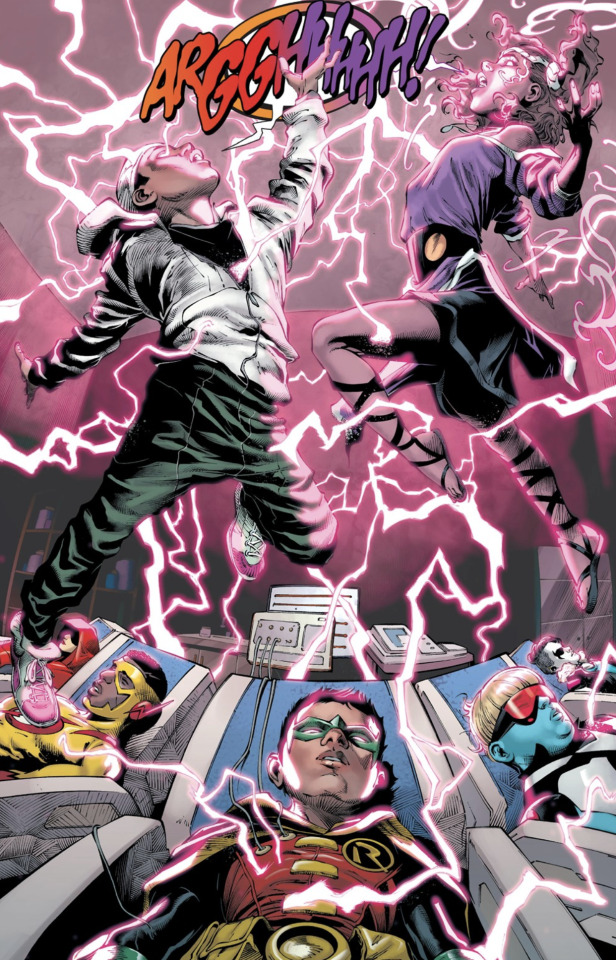
(Then they all portalled to Heaven – see below.)
Time dead: about half an hour if you count all the time since drinking the poison, around a minute if you only count from the time Jakeem tried and failed to recover them with the antidote.
4. Killed by groblins (Dark Nights: Death Metal 1:7, 2021)
Damian, along with most of his family, was killed by an army of Jokerised Robins led by the Robin King (an evil child Bruce from another dimension). His death happens off-panel, but it definitely happens because we see his corpse lying on the ground beside Dick’s.
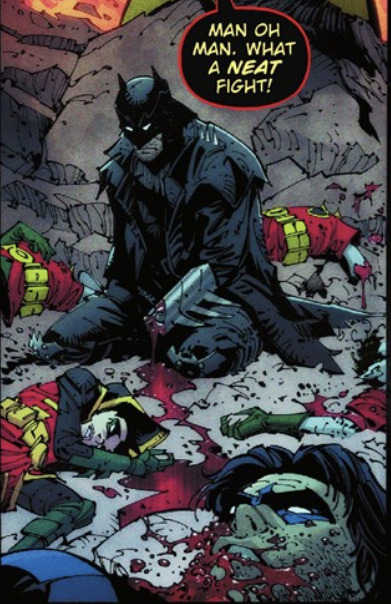
He was raised as a zombie by Black Lantern Batman shortly afterwards to continue the fight.

He was restored to proper life when Wonder Woman persuaded the creators to remake the multiverse as it was before the evil universes invaded the good ones.
Time dead: maybe quarter of an hour; or perhaps a lot longer, if it took longer to rebuild the world.
5 and 6: Killed twice in the Lazarus Tournament (Robin 3:1–2 and 8, 2021)
The League of Lazarus is an offshoot of the League of Assassins, and every hundred years they hold a Lazarus Tournament on Lazarus Island. Everyone who dies on Lazarus Island comes back to life (the clue is in the name) because Lazarus Island is absolutely steeped in Lazarus water from a massive Lazarus Pit. So the rules for this tournament are three deaths and you’re out.
Damian entered the tournament to find himself/prove himself/something. He was killed very early on by Nika (Flatline) who tore his heart out of his chest. She’s good at that. (She later becomes his girlfriend.)
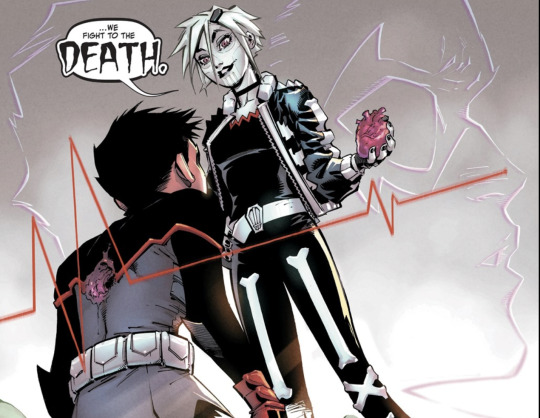
He came back to life the next morning.


Time dead: about 12 hours.
He then managed to survive until quite late in the tournament, when he fought and got his neck snapped by Connor Hawke.
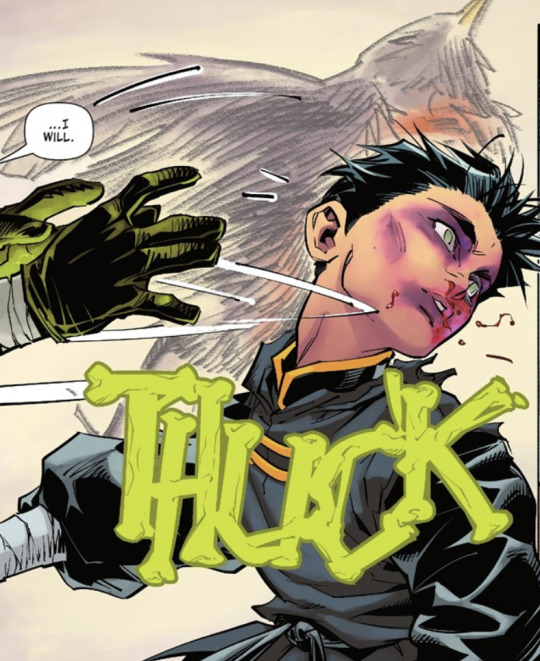
This time he came back within minutes.
(Connor technically wins the tournament, but then gets killed by a Lazarus Demon called Nezha – turns out the purpose of the tournament is to give the demon power so it can rise and destroy the world – and all the contestants join together to fight the demon and get Connor back.)
Time dead: a few minutes.
Bonus extra deaths
(Implied, inferrable, ambiguous and arguable deaths)
1. Perhaps died briefly during a full organ replacement (Batman 1:665, 2007)
Talia set up a big convoluted plot to introduce Damian to Bruce for the first time, and it ended in the Mediterranean with Talia taking Damian away again in a submarine, which promptly blew up (Batman 1:658, 2006).
Damian was seriously injured, and Talia took him straight to a League of Assassins base and called for a ‘full organ harvest and replacement’.

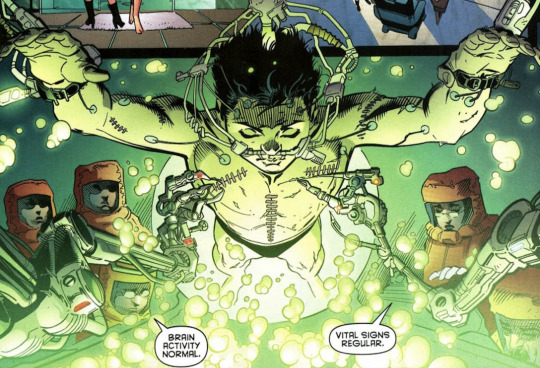
If he needed all his organs replaced, he must have had massive internal injuries. It is plausible that he flatlined once or more before or during the operation, because that’s fairly normal with such extensive injuries.
In addition, the green liquid Damian and what might be his spare organs are suspended in during this process may or may not be Lazarus-related.
Time dead: a few seconds, if any.
2. Perhaps died briefly after Jason shot him in the chest (Batman: Battle for the Cowl 1:2–3, 2009)
After Bruce got lost in the timestream and everyone thought he was dead, Jason decided to process his feelings about that by putting on a batsuit and shooting lots of people dead. When Dick confronted him, he shot Damian in the chest at close range to distract Dick so he could escape.

The bullet bruised a lung and severed an artery, and Damian needed ‘eighty-nine stitches and a transfusion fit for an elephant’. So it’s reasonable to infer that, given the level of injury and blood loss, he is likely to have flatlined at least once during the operation.
Time dead: a few seconds, if any.
Afterlife visits
A fight at the gates of Heaven (Teen Titans 6:41, 2020)
After Damian and his Teen Titans rescued Djinn from Purgatory and freed her from her magic ring (see above), they immediately went after her brother Elias, who was attacking Heaven. Djinn portalled them there using her genie powers.
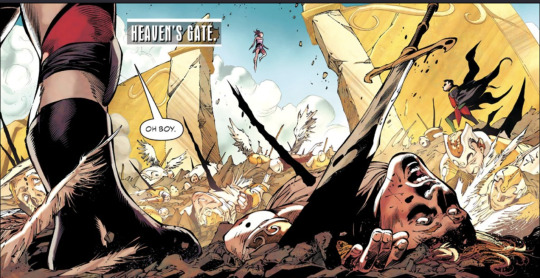
When they got there they found Elias had killed piles of angels and had installed himself in Heaven; the Teen Titans fought and defeated him, and then Djinn returned them to Earth.
Time in/just outside Heaven: as long as it takes to fight the battle; maybe up to half an hour.
Batfam Death Project Masterpost
#batfam death project#damian wayne#deaths of damian wayne#corpses#I will edit this post if I discover any further deaths
25 notes
·
View notes
Text
Dark Crisis on Infinite Earths:
I finished working my way through this as an event, and I've got to say that DC can't decide what it wants to do with the Multiverse. We've just gone from restoring the 52 Earths (Mostly around Convergence/Multiversity) to discovering the Dark Multiverse (Dark Nights: Metal, 2017), to rebooting the Multiverse at the end of Dark Nights: Death Metal to form the Omniverse (2020), but also restrict things back to 52 Earths only, to rediscovering Infinite Earths in Dark Crisis (2022), to the conclusion of Absolute Power being "we have once again cut off the Multiverse, but now we're going hard for Elseworlds instead" (2024). Make up your minds! Do you want to use the multiverse or not??? Please stop switching it up every 2 years!
Okay that rant aside, this is yet another event that cares very deeply about plot points and characters from COIE that have barely been seen in the intervening 36 years (and generally only in other events that reference COIE heavily). I don't have any emotional attachment to Pariah and the Anti-Monitor.
Structurally, it was an interesting event, in that there were about 4.5 plots going on.
Plot 1: the Justice League get trapped on dreamstate Earths born out of their subconscious wishes. In terms of commentary, Barry trapping himself in a 1950s comic book, Clark wanting to raise Jon (on the farm, with literally no other heroes from the Superfamily around), and J'onn J'onzz creating a future where he's merged humans with cephalopods/octopus so that they're psychic were probably the most interesting of the lot. Barry proves once again he's disconnected from the present, Clark is obsessing over his loss of Jon's childhood at the expense of everyone else, and J'onn...is once again mourning the loss of his culture and looking for a way to feel less disconnected from Earth. Still not quite turning into the sands of Mars tho boyo. Blah blah the League are feeling they're not communicating properly, they need to take a break and focus on themselves.
Plot 1.5: The Flashfam go to extract Barry and work out WTF is going on because they're the most reliable multiverse jumpers, and the Lanterns recruit everyone as bodies are needed (as all the heavy hitters are as stated trapped in dreamstate Earths).
Plot 2: Jon Kent forms the most underskilled novice Justice League since the early 1990s that largely consists of the latest legacies of various families, getting some direction from Black Adam. Their collective experience as superheroes MIGHT total 20 years active, and if it makes that it's because Booster and Ted are supplying most of that experience.
I am underwhelmed by this team, to put it mildly. There's a lot of "I need to be Superman as my father isn't here!" from Jon, and a lot of boring "Damian grows up to be Batman" foreshadowing where Damian outright insults people a lot, and Yara looks confused and irritated over why she's hanging out with them both. Jackson's trying his hardest, bless his heart, but because nobody really cares much about the Aquas they get that bit of the plot out of the way early on. I'm not sold on what this lot were actually trying to accomplish, despite once again being presented at the future of the DCU.
Plot 3: Dick and the Titans realise they have to step up to actually take leadership, because as noted Jon Kent's Justice League is out there competing with Justice League: Task Force days of "there are four warm bodies here, and only half of them are under the age of 18, we're good to go right?" for level of threat defence. Also Slade's busy trying to kill both Dick and Gar because he can something something dark forces corrupting him mad about Grant's death for the 87th time blah.
Plot 4: Young Justice get kidnapped into a further separate reality to keep them out of the way while the two generations on either side of them try to step up to leadership, and have a bunch of angst about being left out/left behind (I am going to discuss this separately. Spoilers: I thought it was one of the most interesting parts of this event).
My general impression of the entire event was the intended purpose was to showcase both Dick and Jon's leadership abilities. I think it achieved this, but not necessarily in the hoped for way. Dick showcased once again why he is the centrally trusted character of the DCU and can convince everyone and anyone to follow him. Jon showcased that he is absolutely not a leader, he needs to stop thinking that he is required to fill Clark's shoes, and DC need to stop trying to make it happen.
The bit where I most started rolling my eyes is when they decided that Jon Kent, half-Kryptonian powered by sunlight, from a species famously incredibly vulnerable to magic, needed to lead the team going into the magical pure darkness/demon dimension that has no sunlight "because his connection to the sun protects him". Jon's biggest weakness not starting with K is magic. So let's put him in a dimension consisting of magic and have him have to survive off the power of his sunlight...which he immediately wastes and burns off a lot of power by trying to fly. Power that he can't recover, because he's in said dark demon dimension with no sunlight.
Jon, sweetheart, you are not the brightest bulb.
My second biggest eyeroll was meeting Red Canary, Sienna, who accomplished exactly nothing when she accidentally got caught up in Damian's strikeforce that otherwise consisted of "a teleporter for travel, Peegee for her experience with the Cosmic Tuning Fork, and Dr Light because Kimiyo is both COIE linked AND has strong light based powers to fix the situation". I am still unsure of what the point of Red Canary being there was, because she mostly just snarked with Damian and got into trouble. Even if she was intended to eventually be revealed to be Sin Lance with memory problems or something she was not a convincing character.
The Flash storyline in and of itself was fun, but I'd actually already read it when I was reading through Adams' Flash run. It worked just fine in context of the event and it worked as a tie-in where you just skimmed over the event. Adams' Flash run is very entertaining.
As far as DC big summer events go, this one felt more about 'we want to reach these end conditions' (Justice League disbanded for a while, Justice Society of America back, Titans to step up as the headline team) than the actual content of the event itself. It was an event for the sake of having an event, you know?
I dunno. Maybe I would have cared more if I'd actually read COIE, but it felt derivative and like there was a lot of time wasting for the sake of referencing specific things that happened in COIE, whether or not they made sense for this storyline.
Oh and as a note, one other useful thing this event did do was specify that Supergirl: Woman of Tomorrow is supposed to be in continuity for Kara, and basically contemporaneously too.
#z canon read throughs#recent reads#dark crisis#honestly the funniest part of the entire event was J'onn inventing a world where everyone had Davy Jones from PotC's head#Good work there J'onn. As always I am in awe of your coping mechanisms over your loneliness#this was not the most heartwrenching version of it (see DC One Million and the sands of Mars) but it was a fun one
22 notes
·
View notes
Note
Sorry to bother you, but you seem to know a lot about the comics, and specifically about Tim Drake. I was wondering if you knew off the top of your head when Tim and Steph last canonically dated? Because I see people blaming Meghan Fitzmartin a lot, but I could've sworn that they last broke up before she became Tim's author.
So, the people 'blaming' Meghan Fitzmartin are correct—but I can understand some confusion happening because the breakup occurred off-panel. So like, if you weren't following things closely at the time these books were coming out, it might seem like the first Tim story Fitzmartin wrote was referencing a breakup that already happened somewhere else... but that is not the case.
The other possible confusion point would be that there was an earlier 'break up & get back together' storyline with them in the Rebirth era, a few years before she wrote Tim.
To briefly go over the Rebirth & onward Tim/Steph dating timeline just to clear things up (and I'll be using cover dates just for consistency, so if you want release date subtract two months):
Detective Comics #934-935 August 2016 [written by James Tynion IV] Tim & Steph are established to be dating in Rebirth continuity. We don't see the actual moment they start dating, we're just shown that this is now the situation.
Detective Comics #940 November 2016 [written by James Tynion IV] Tim is 'killed' (he's not really but everyone thinks he is, and he is out of the picture for a while) and thus that effectively pauses any relationship between he and Steph, obviously.
Detective Comics #969 January 2018 [written by James Tynion IV] Tim is back and reveals himself as alive to Steph, and the two of them resume their relationship. After a short timeskip, we then learn that in the aftermath of his return... Tim is not being honest with Steph about his plans (to not go to Ivy like he said he would, to instead continue hero-ing indefinitely).
Detective Comics #970 February 2018 [written by James Tynion IV] Tim & Steph start to have some tension here because of how he's overworking himself, how he's handling things with her, and there's a moment where she says she's leaving, he asks if she means 'The Belfrey, the team, or me?' and she says 'I'll get back to you on that.'
Detective Comics #974 April 2018 [written by James Tynion IV] In the aftermath of the team sort of exploding due to ~plot events~ Steph breaks up with Tim while he's throwing too much of himself into his work.
Detective Comics #981 July 2018 [written by James Tynion IV] More plot stuff happens (a whole big mess with Brother Eye) but once that's settled, the two reunite and rekindle their relationship as they head off ‘to Ivy University’ as they tell Bruce, but we know that’s not actually where they’re going.
Young Justice (2019) #5 July 2019 [written by Brian Michael Bendis] Flashbacks show us that after leaving Gotham, Tim & Steph had specifically gone to see the Justice League/Zatanna for help with timeline memory things rather than going to Ivy. Even though they’re in separate places at the main timeline of the book, this shows us that they're still together.
Young Justice (2019) #11-20 February 2020 - January 2021 [written by Brian Michael Bendis] Steph & Tim immediately try to get ahold of one another via text once Tim's back on the correct earth, and work on getting back in touch until eventually reuniting. They are shown together [and depicted as still dating] during the later parts of the book.
Dark Nights: Death Metal: The Last Stories of the DC Universe #1 February 2021 [written by Joshua Williamson, James Tynion IV, and Scott Synder] Shows the two of them together within the larger group of former Titans/YJ members—specifically one panel towards the end shows us Tim with his arm around her while they talk with others [fun fact that’s the panel my icon is from I just had edited Steph’s head out of the way]. As I recall/as far as I'm aware, this issue is the last time we see them interacting together/together as a couple before Future State and then the Infinite Frontier relaunch. [disclaimer that there could be like... a splash page group shot or something that I'm forgetting elsewhere during the Dark Nights: Death Metal event but like, that's not actual interaction that's just physically being present in the same group shot].
NON-CANON BUT RELEVANT: Future State: Robin Eternal #1-2 March - April 2021 [written by Meghan Fitzmartin] During the Future State event which was used largely to tease/set up plotlines for the Infinite Frontier relaunch, in this potential future Tim & Steph are seemingly no longer together but still on okay terms—teaming up in the story, but with clear tension and history there.
Batman: Urban Legends #4 August 2021 [written by Meghan Fitzmartin] We learn that Tim & Steph broke up off-panel before the events of the issue. Steph appears in the following issue further reiterating that they recently broke up.
So yeah! They broke up off-panel and this was first referenced in Batman: Urban Legends #4, thus under Fitzmartin's pen.
#sam explains#i did briefly reread each of these issues im referencing here to confirm they had the content i thought they did but i was doing that#in a very Speedy way so. keep that in mind. but like the general events here im certain of. + i was keeping up with almost all of these#things as they originally were released. [except like. some of the later parts of the 'tec run. i was there at the start but checked out#for a while bc busy with college lmaoooo but i was back in and keeping up with stuff once later parts of YJ 2019 was coming out]#<- though to be clear i have READ all of these. i just mean the later parts of 'tec i read like a while after their release
64 notes
·
View notes
Text
Three Jokers Are Not Better Than One
(or, cheap twists don't make a good story)

Would you look at that? It's time to bitch about Three Jokers!
(spoilers for a 3-year-old comic ahead)
Gotham War got me into hater mode, so I figured it was time to take a second look at Three Jokers, written by Geoff Johns and drawn by Jason Fabok. I first read it when the issues came out, and I thought it was possible that the story isn't as bad as I remembered. I don't know why, since for the past three years I've been haunted by the possibility of it being deemed canon.
Of course, at the time of conception, Three Jokers was intended to be canon. Johns set up the premise in the Darkseid War storyline of the 2011 Justice League run, in issues published in 2015/2016. Batman takes control of the omniscient Mobius Chair, and he tests it by asking who killed his parents. Then he asks a second question, which Hal Jordan presses him on several issues later.
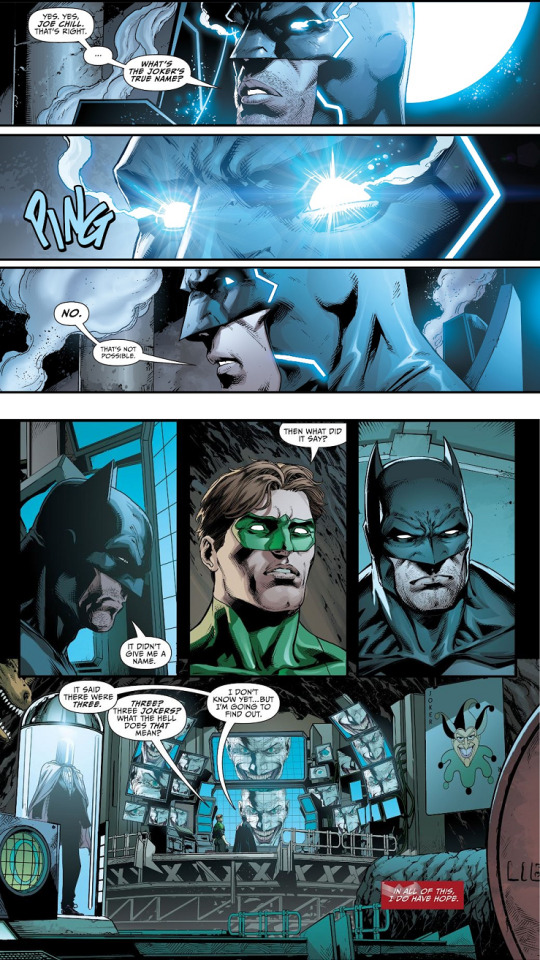
[Justice League (2011) #42 & Justice League (2011) #50]
Four years later, when Three Jokers was set to be released towards the end of 2020, Johns did at first confirm it would be canon despite being released via Black Label, where books are not meant to be part of the larger continuity. In later interviews, however, this assertion got walked back in favor of saying the canonicity is up to each reader, which is kind of a wild thing to say. "Look, this story merely proposes that one of our most popular characters has actually been three different dudes the whole time, which totally has a negligible impact on how that character should be seen and has interacted with the world. Take it or leave it!"
But then, DC's idea of canon has been pretty squiggly of late, especially with the increasing multiverse shenanigans. In the final issue of Dark Knights: Death Metal in 2021, the reader is told, "with our past finally set, myriad new futures are opening up. And as hypertime heals, we'll likely experience flashes of them– and even alternate pasts– in pretty epic fashion." Infinite Frontier followed, with a press release declaring, "When our heroes saved the Multiverse from Perpetua in Dark Nights: Death Metal, everything was put back where it belonged… and we do mean everything. All the damage from all the Crises was undone [....]"
I have a lot of thoughts about this, revolving around what the heck does it mean for storytelling and how we should understand characters that apparently, somehow, everything is canon? How are we supposed to take this as anything other than the omniverse being an excuse for DC Editorial to wave off responsibility for a legible timeline? "Batman can be in two places at once because, uh, the Monitor sneezed?"
But this too-long essay is about Three Jokers, so I'll narrow my concern: if character histories can simply change with a multiversal glitch, in whatever overwrought way those are usually explained to us, then it sure feels like it doesn't matter that Three Jokers was published under Black Label. It sure seems like, at whoever's whim, Three Jokers can still get locked into the main storyline. I mean, Zdarsky still hasn't explained what that three Jokers shit in Batman #135 is about. On the other hand, we know that the explanation for the two Jokers in The Man Who Stopped Laughing does not involve the multiverse, and Joker is supposed to reunite with Batman over in Zdarsky's story when that story closes out, so… I actually have no reason to be confident that means anything.
"But why would Three Jokers getting canonized be so bad?" you may ask if you've never read Three Jokers (or if you fully enjoyed it).
Speaking for myself, it starts with the premise: taking a character and saying, "actually, this is not one complex guy but three different guys, which fractures the character's motivations and relationships over the last several decades." When that character is one you enjoy very much, this twist is not fun. It's a fundamental change to who they are.
Then five months before the release of Three Jokers #1, Johns and Fabok did an interview with Entertainment Weekly. Some things the pair said raised red flags:
1) Three Jokers' story would focus on the trauma that Barbara, Jason, and Bruce suffered at Joker's hands, per Johns. "If you suffer some trauma, you don’t just get over with it and move on with your life, it changes who you are. Sometimes it changes you for the better, sometimes it changes you for the worse. You can heal right, and you can heal wrong. That’s really what the book’s about: Healing right, healing wrong, and surviving."
2) Johns also said of the story: “It goes back to the beginning when Batman first encountered the Joker, but it’s also The Killing Joke and A Death in the Family that speak to the book and that we’re building off emotionally." And Fabok mentioned that the book's look would be based on the aesthetics of The Killing Joke: "I really want it to feel like it could be a spiritual sequel, at least artistically."
These remarks foreshadowed a disconnect. A key part of The Killing Joke itself is that both Joker and Bruce experienced terrible trauma ("one bad day"), but in responding to it, they made different choices: broadly, Joker choosing to hurt people versus Bruce choosing to help people. Johns excluding Joker from his comments about trauma felt like a sign that he ignored a key part of the character, despite Joker being a core part of a new tale "emotionally" inspired by TKJ.
(We're setting aside "you can heal right and you can heal wrong" for now. Ohhh, we'll get back to that.)
Johns' blind spot was confirmed a few months later when he was quoted by the DC Nation Twitter account: "There are very few characters that are, to me, as irredeemable as The Joker. There is nothing in him that is good."
Wow, what close analysis from Mr. Emotional Build.
Look, I don't need Joker to be redeemed or woobified. (Ask me about the "Pushback" storyline from 2004 and hear my gnashing teeth crack a filling.) But I would like the full breadth of his character acknowledged, especially when you're claiming you're writing about trauma, especially when you're creating a "spiritual sequel" to one of best known Joker stories (if not the best known one).
Then Three Jokers finally came out, and over three months it proved to be neither an examination of healing nor very interesting, at least not in an enjoyable way. What it has to "say" about trauma, for any of the characters, is no different than the limited conclusion made in previous Batman books: mainly the drumbeat of fighting off the darkness by being a bigger person— or at least not killing your enemy. Making Joker into a role played by three different people adds nothing; it amounts to little more than a gimmick.
Hell, even as a gimmick, it's flawed. Theoretically, the three Jokers represent phases of personality the Joker has embodied over the years— but the representations we get don't make sense. Here they are summed up in Book 3:

Sorry, what? The Criminal is less interested in theatrics? In what time period was the Joker ever not interested in making a big show of things in one way or another? Maybe this is supposed to be an "early" Joker in terms of the Rebirth/InfiniCrisisDarkCarnateTier/whatever more recent conception of him, but I'll wager that's not what people think about when they think of Joker at his start. They think about Golden Age Joker doing goofy shit and laughing maniacally. They're not expecting this morose man.
The other thing is that, in Book 1, the narrative "assigns" each of our three protagonists to a Joker: Bruce to the Criminal, who appeared at the start; Barbara to the Comedian, who shot her; and Jason to the Clown, who killed him. Now at first I thought Johns was saying one Joker took over after another, but since Barbara's attack and Jason's death happened 9 months apart in 1988, which are not different Joker eras, I think we're supposed to see them as sort of… cycling on and off depending on the needs of the scheme? Maybe? But the descriptions above are still confusing. Why am I supposed to see the Joker who got carried away with the fun of beating Jason with a crowbar and successfully blew him up as less sadistic than the other one?
Johns does appear to lampshade this confusion in the middle of Book 1, when we get all three Jokers in a cabin in the woods. The Clown and the Comedian have this exchange:

This and a later panel with the Comedian actually imply that he and the Clown are interchangeable, even though they're supposed to be different. So are they or not? Is there an actual reason we need three Jokers, or did Johns just think it was a neato idea and then spend four years trying to figure out a "layered" justification for it?
The other thing about this cabin scene, and about the Joker trio largely, is that it should be fun and it's not. There should be chaos! Zaniness! At the very least, all the narcissism in the room should generate a competitive friction, make their interactions more dynamic. (Really it should generate bloodshed and end with one man standing within like ten minutes, but I'll grant the choice to save that for Book 3.) Instead it's almost mundane. The cabin isn't even decorated! It's dark and dreary, like the Jokers are dark and dreary. If we're gonna have three Jokers, can't they at least be Jokering with each other?
The same thought comes when I consider the very beginning of Book 1. It all starts out like a typical Batman story: three deadly crimes are committed in one night, the Joker seemingly responsible for all of them, and Bruce, Barbara, and Jason are drawn together as they try to figure out what's up. Of course, thanks to the Magic Chair, Bruce already knows there are three clowns, but Barbara and Jason are thinking that Joker is working with two look-alikes to create confusion. And considering the basics of what happens in this story, what the Comedian's larger plan is meant to accomplish, why couldn't this have been written with just two look-alikes? I mean, yeah, it would require Johns to forget about his continuity bomb, but maybe the story would have been better (and shorter). Again, the creation of other Jokers isn't doing much for what the plot is getting at. The three crimes that start us off would still serve the function of reminding Bruce of how Joker's been a constant in his life. The taunting of a convincing Joker look-alike is enough to set off Jason's anger and sadness about what happened to him, and his fears of what he could become. The climax with Joe Chill would have to be redone, but the threat of him being Jokerized isn't the crucial plot point; the Comedian's film of him is. Bruce doesn't even have any substantial thoughts about there being three of his nemesis.
But, alas, the story goes how it goes. And as it goes, we also see that Jason behaves more cruelly in his search for Joker than Barbara and Bruce. For example, Jason attacks and threatens one of Joker's victims to get information, feeling justified because the guy has a rap sheet, while Barbara scolds him and Bruce tells the victim, "I'm sorry this happened." What I find notable about this is that while comics regularly present Jason as hot-headed and Barbara as reasonable, Bruce… uh… If you gather a random selection of Batman comics, you'll find that his level of violence is all over the place. This story, however, requires a more somber Bruce, whose violence is more reactive, because Jason and Barbara serve Johns' dichotomy of "heal right" versus "heal wrong." We can't have Bruce on the sadistic side of the scale fucking that up, and besides, Jason's long been the posterboy for healing "wrong."
That notion comes to a head at the end of the issue. The heroes have encountered and subdued the Clown at the aquarium when Jim Gordon calls. The GCPD found another Joker, and Bruce leaves Jason and Barbara alone with the Clown to assist.

Goodness me, who could have predicted Jason might kill a restrained Joker? Not Bruce, who absolutely should have. Barbara is there to talk Jason down, sure, but what else is the Clown gonna do but needle Jason to kill him?

The Clown cackles then, declaring that Red Hood is his Robin, for the very reason of his violent impulses and how much he upsets the Bat, and of course Jason shoots him in the head, because oof.
Honestly, on this second read I found this scene a smidge too oof. Jason was a determined little Robin, dedicated to saving his awful mother to the very end, and him cracking and declaring that he'll work for a criminal… I don't know. I don't think it's impossible, but it feels superfluous. I don't think such a reveal is necessary to get Jason to fire. I think the Clown focusing on how the new Red Hood is actually quite similar to the old, as well as how Jason matters less than the neverending battle between Batman and Joker, is enough emotional stress to get to the same end result.
But that's a minor quibble; we've got bigger fish to fry! Such as the specter of the "healed right/healed wrong" dynamic that reappears as Barbara and Jason argue over the Clown's corpse.

Barbara leaves angrily after this, but man. I wish the story overall took more cues from this scene, that in a Black Label story we could stray from the simplistic idea of how a Good One would save Joker and a Bad One wouldn't. I want to explore Jason's assertion that Barbara didn't do her best to uphold Bruce's one rule. I want to know if maybe she's tired of being the fucking Good One.
Hell, let's go further: what if we were surprised by Barbara killing the Clown before Jason could? The Clown's taunting about Jason could have gotten to her too. We could have a story about how being put on a pedestal as a Good Victim is a cage, about Barbara struggling with falling from that position, about Jason feeling unsure if he should commend her for an act that obviously hurts her or comfort her for something he would have done himself. That's an actual examination of the struggle to process violent trauma— that you don't need three Jokers for!
But the story we have never gets back to Jason's suggestion that Barbara let the murder happen, not in this issue or the following two. This issue just ends with Jason hoping that the Clown was the actual Joker and that he didn't kill the wrong guy, which is a pretty "LOL oh yeah" line when you remember that he and Barbara don't know there are three Jokers yet.
Book 1, truth be told, isn't that bad. On my reread, I started to wonder if my only real issue with the story is that it's not as engaging as all the hype insisted it would be.
Then Book 2 starts, and goddammit. GODDAMMIT.
I've said it before, and I'll say it again: why can we not have more DC writers having fun with Joker's multiple-choice backstory? Why did Johns read The Killing Joke and decide his interpretation would be this?:
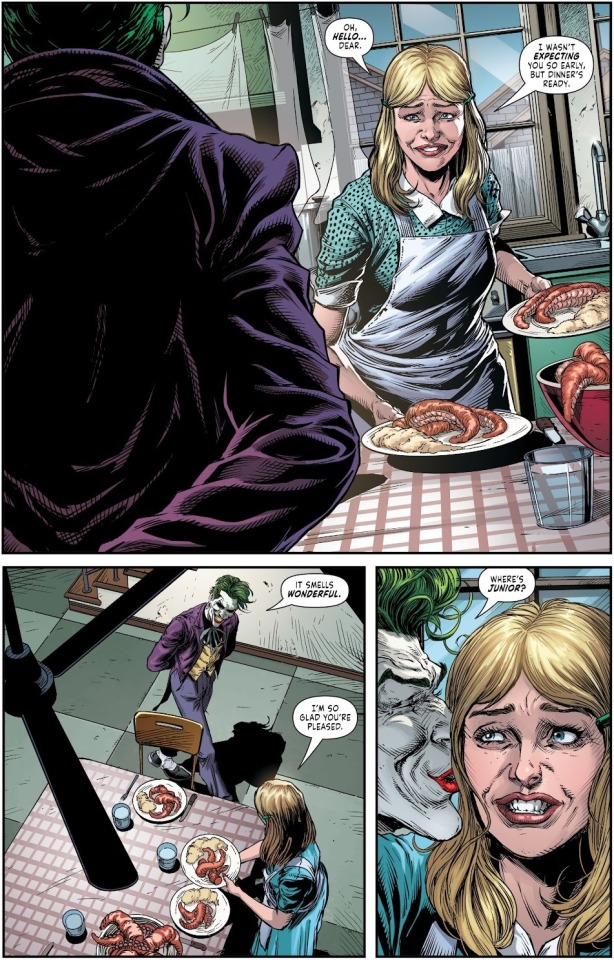
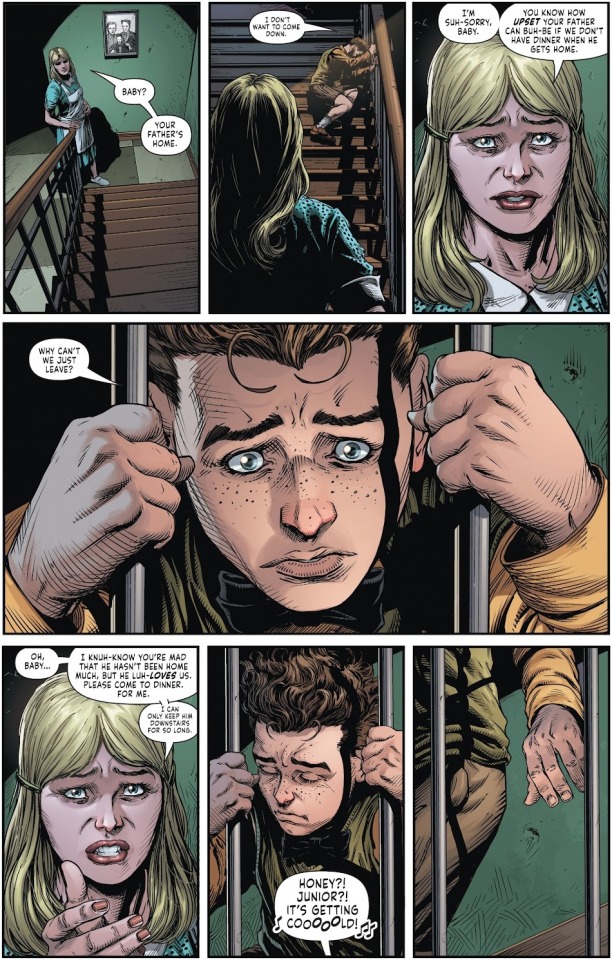
Ugh. UGGGHHH.
I don't recall the issue, but there's these panels that circulate sometimes of Harley Quinn encountering Joker in Arkham or prison, in which they exchange words about their relationship and he's a creep and she kicks his ass. I have no problem with Harley kicking Joker's ass. He deserves it. My problem is that those panels play out like an empowerment scene in a generic Lifetime movie. My problem is that it doesn't have the flavor of Harley and Joker. My problem is that it's lazy.
And that's my problem with what Johns does with Joker's backstory in TKJ. He could take it anywhere, and he goes gritty without an ounce of nuance. Because hey, this is Joker, and "there is nothing in him that is good," right? We'll just ignore that one of DC's all-time classics, the one this garbage is ✨inspired by✨, has Joker reflecting on a past for which he is an unreliable narrator, but in which he laments how his comedy dream put his growing family in a bad spot, in which he desperately aligns with shady people so his family can be secure, in which he's devastated by losing the only person he has in the world and their growing baby. And these memories could be distorted or entirely fake, but what's interesting in TKJ is that Joker never tells anyone else about them, even in his big speech to Batman. The flashbacks are not part of an attempt to manipulate anyone or convince them his world view is correct. It's a tale in Joker's head that, regardless of the truth, deeply affects him. It's what drove him to go to horrendous lengths to prove his point, even if the point is wrong.
But fuck that, right? We're going lazy! We're going cheap! We're going with the Jeannie backstory, but actually Joker was only terrible to her. The Comedian fondly fantasizes about terrorizing her and their son, because he's 100% an abuser, because he must have always been that way, with not a single appealing quality that we need to reckon with as we so often do with toxic people in real life. Even the freaking stutter Joker had as he struggled with stand-up comedy is given to Jeannie. Seriously?
I cannot emphasize enough: fuuuuuuuuuuuuuuck this "take."
On the other hand, when the Comedian is brought out of his stupor, we do finally get something super funny:

At least we'll always have this panel of Joker eating cat food.
The Criminal only interrupted the daydream because he's mad the Clown is dead, and the Clown was so eager to be dead I thought it was part of their plan buuuuuuut I guess not. Then we jump to Bruce figuring out that the "Joker" that Gordon cornered is just another victim, a dead judge. Barbara appears to tell Bruce what Jason did, and they discuss it over comms on the road.
Bruce, shockingly, says that they can't really do anything about what Jason did.
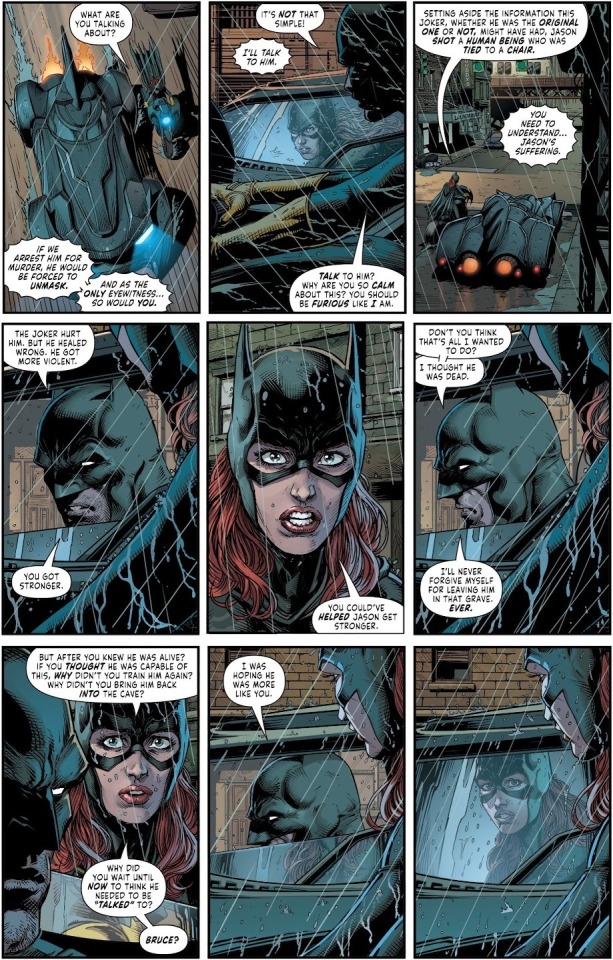
Pretty sure the guy who batarang'd Jason's throat rather than let him kill Joker would have a more intense reaction than this?? Or any reaction other than sober understanding? Maybe Bruce is still coping with finally dealing with three Jokers at once and will flip his shit when this all resolves. Or maybe he's just thinking, "it's okay, I still have two emotional support clowns left!" I don't know. He's so weirdly passive in this story.
What's more aggravating, though, is the other aspect of this conversation, that Jason "healed wrong." It would be one thing as a pat judgment Bruce is making, but we know from that interview that Johns positioned "healed right versus healed wrong" as the story's theme. It's not good. It's way too glib a framing for evaluating how people who've gone through trauma are dealing with it, in any context. Sure, there are better and worse coping mechanisms, better and worse outcomes, but healing is an ongoing process that can be so individualized. Reducing it to "right" and "wrong," saying that one is "strong" and implying that the other comes from some sort of deficiency… I hope Johns just spoke poorly and he does understand that it's not that simple.
Now, is it a stretch to apply that critique to Jason killing criminals at his whim? Sure, deciding that you personally should play the role of judge, jury, and executioner is not a good way to deal with trauma. But that's not exactly what's happening here. This "healed right versus healed wrong" framing is being applied to Jason Todd going after the Joker. Obviously, I like Joker, but can we be real about this? Can we be real in a Black Label book, the imprint where comic books (allegedly) have room to take things more seriously? Can we take the question of, "In this fictional world where Joker is an unstoppable fatal mayhem machine— now THREE machines— is it completely out of bounds for someone to finally kill him?" and be like, "Errr…not really?" When this story explicitly denies Joker even one teeny redeeming human quality, are we seriously still going to say, "Well, you know, if Jason takes the life of the man who murdered him and millions other people, because he doesn't want him to kill more people, which Joker will absolutely do and we all know it, doesn't that say something awful about Jason?" Are we really??
Plus the judgment about healing is put into the mouth of a man who— say it with me!— regularly dresses as a bat and beats the ever-loving shit out of people because his parents were murdered. Toning Bruce down in this particular story doesn't hide that.
Although, what I think is intended as a flawed assumption on Bruce's part is his other line, "Jason's suffering." It implies that Barbara still isn't, but we are shown Barbara reflecting on her paralyzation, even now when she's "strong" and has healed "right." And the story will get into this a bit later, but it absolutely does not let Barbara and Jason escape the dichotomy. To the story's detriment, their interactions go in a wild direction, but we'll get to that.
First, Bruce and Barbara's investigation leads them to Blackgate, because the fingerprints on the murder weapon for the dead judge belong to none other than Joe Chill. However, we learn that Chill has been in the medical wing for two months because he's sick with cancer.
Meanwhile, Jason's investigation leads him to a closed athletic center. The pool inside is filled with the chemicals stolen from Ace at the start of the story, as well as dozens of pale naked bodies with green hair. Jason's attempt to contact Barbara is interrupted when one of said bodies bursts to life and grabs his ankle, asking for help. Jason reacts with hostility, kicking the poor guy, and I'm not sure if it's because he's unnerved by a room of floating Jokers or if it's pretty normal for him to not keep his cool even for the sake of an obvious victim of a horrible crime. A Gotham City vigilante can't be that shocked by one guy being alive in a pile of bodies, can they?
But that's all setup. When the guy falls unconscious, the Criminal and the Comedian ambush Jason and drag him away, one saying, "He'll be perfect."
It's a line that meanly gets your hopes up, poking at a subject that could make all this more interesting.
Jason awakes, strapped to a chair and as naked as the bodies in the pool. The Criminal says he and his pals have spent a lot of time trying to find the perfect candidate for a new Joker, and he repeats the question of what's up with Jason taking on the Red Hood moniker.

It seems that, like DCAU Tim Drake in Batman Beyond before him, Jason Todd will be transformed into a fourth Joker! But it won't only be because it will wreck the Batman. It'll be because Joker already sees himself in Jason. This is something new to explore! There are places to go here; other comics hinting at Joker's past point to him having a childhood not dissimilar to Jason's, of growing up on the street, experiencing abuse, and learning unpalatable ways to survive. We could see Jason struggling with the possibility that he has more in common with Joker than he wants to think about!
But we won't. Inexplicably, the Criminal turns around and says that despite their similarities, despite Jason hating Batman as much as he does, despite the Comedian (presumably) saying Jason is perfect, and despite getting Jason ready for the pool, Jason actually isn't good enough, not "bright" enough. (Because all the Jokers we have in this dour story are so bright?)
And then the Comedian just beats the hell out of Jason (saying it's more fun than the first time, in another annoying nod to how he and the Clown are the same damn Joker) and says they're leaving Jason alive because maybe he'll prove them wrong and he'll become a new Joker after all? But the current Jokers aren't really going to go for it. Their interest is just abandoned.
The point is only to freak Jason out, so when Bruce and Barbara arrive, fight a horde of Jokerized victims, and find Jason alone and naked and vulnerable, he does not react well when Bruce tries to ask if he's okay. Jason turns on him and blames him for setting him on this path, for leaving him in the dirt, for replacing him easily. He lashes out at Barbara too, asking if she's going to lock him away, but ultimately it's easier to take comfort from her.
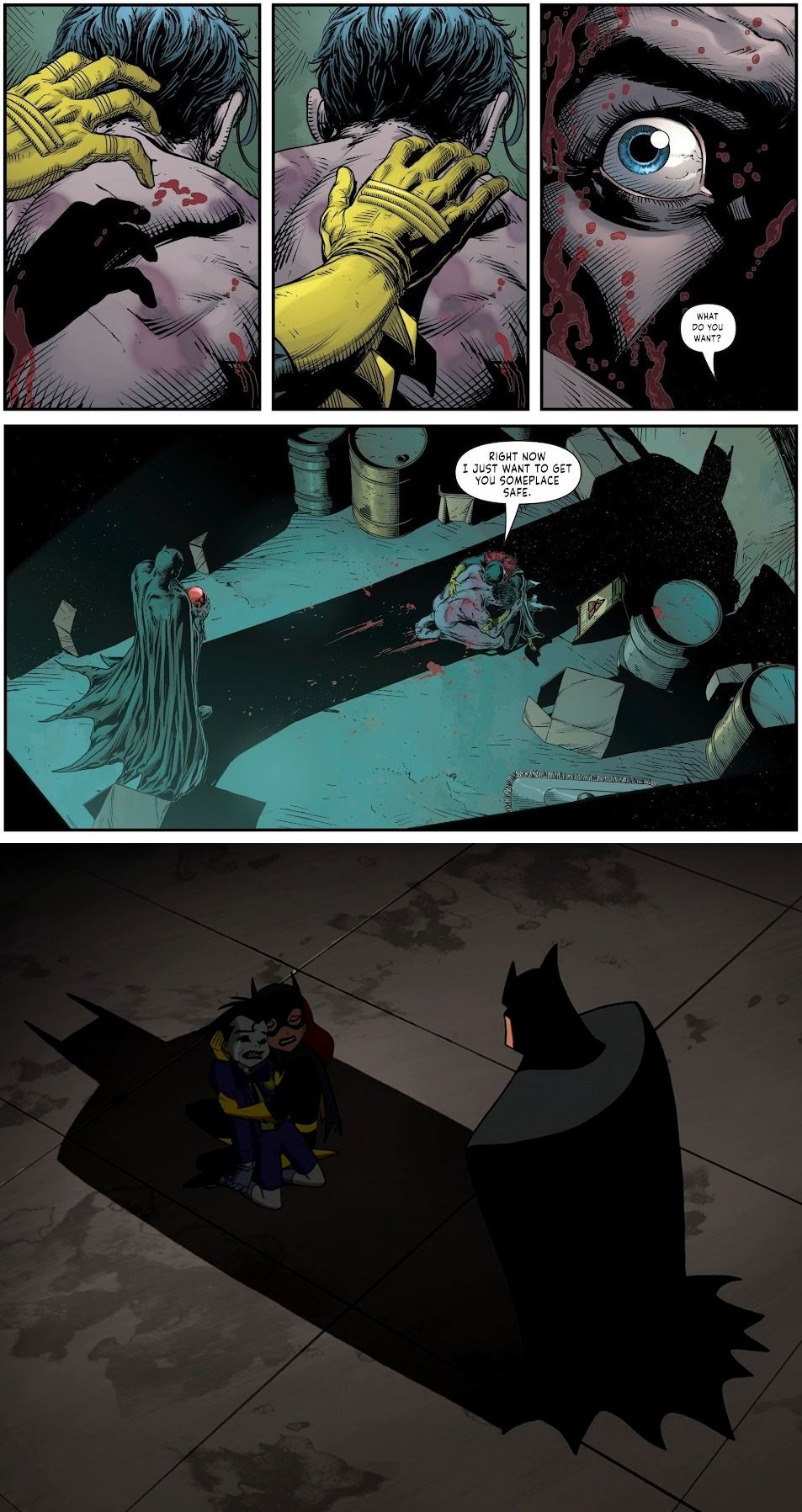
A direct reference to Return of the Joker here, focusing on the shadow Batman casts over the lives of his partners, the responsibility he bears in how Joker targeted them to hurt the Bat, and how poorly he offers comfort himself.
It does segue nicely into the next scene, when Bruce and Barbara get Jason to her apartment to rest. Bruce leaves to keep investigating, and Barbara is pissed because this is the exact lack of support that contributed to Jason going his own way. Support is highlighted again when Jason wakes in Barbara's room and looks around.

Aside from Barbara seeking out books to deal with her physical and mental struggles after Joker's attack, the old calendars show the help she received from her father and health professionals.
And this scene does get into something that's missing from TKJ, in which Bruce tells Joker that no, not everyone will retreat to madness like he did. How we react to trauma is greatly affected by the resources available to us.
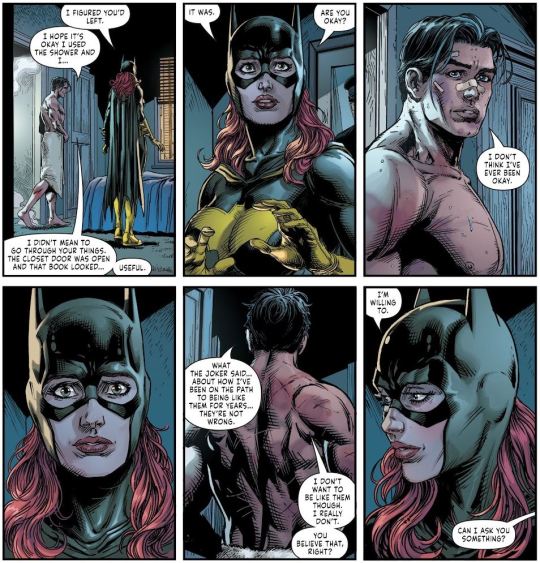
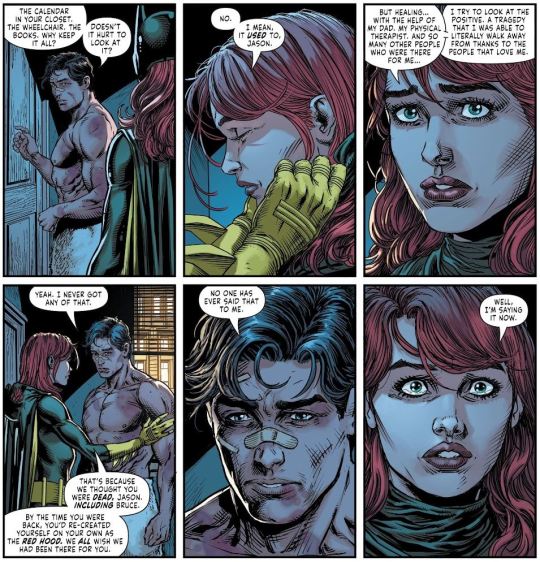
This scene is nice. It's nice to come from the action to some place quiet and for someone to say this Jason, something he's wanted to hear. It's late in coming, but it's pain validated.
And then Johns fucking ruins it.

Man. Just. Ugh. Yeah, I know people seek comfort in moments of vulnerability, but… the reader knows. The reader knows moments like this aren't included to be like "oh, this was an isolated blip of human behavior! The story won't call back to it later!" Johns apparently wants Barbara/Jason to be a thing. And if you want a solid reason for that… well, we don't get any good ones.
Meanwhile, Bruce is in the cave, and I'm only mentioning that because these folder labels are incredibly funny:
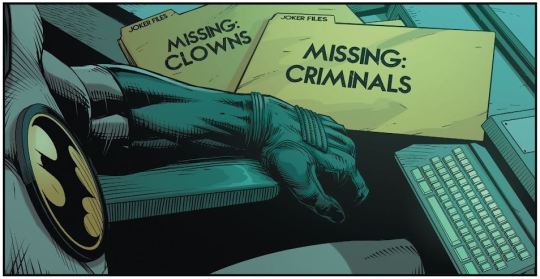
Then the issue ends with Joe Chill kidnapped from Blackgate by the Comedian, who has a video camera and asks him to talk about why he really killed the Waynes. Dun dun dunnnnnnnn! Is that a twist on the way?! Well, yeah, but not really the one you think and it's incredibly stupid.
Finally we are at Book 3. Jason is suited back up, and he and Barbara have met up with Bruce in the cave to figure out how the Jokers plan to create another, better Joker.

Soooooo Jason and Barbara had that whole conversation. Jason was shaken by what the Jokers said to him. But now he's completely back on track. Allllllrighty.
Jason and Bruce then have an argument rehashing everything that Barbara said she was sorry Jason experienced, with Bruce saying of course he'd love to kill the Joker, and Jason pointing out that he obviously hasn't. Jason also says he thinks the only reason Bruce isn't turning Jason in for killing the Clown is to protect Batman's identity. Barbara just tries to de-escalate with her doe eyes. They're back to the status quo, and it sucks, which is the point. When they try to get back to the investigation at hand, Bruce pauses and attempts to apologize.
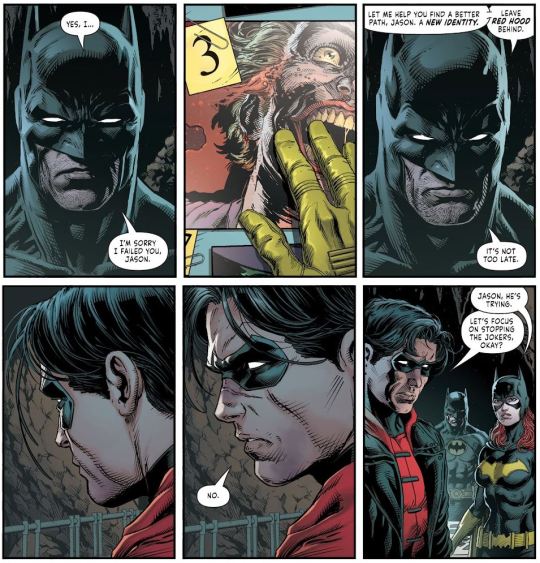
And again, with this blatant TKJ reference, it feels like we need to dig into the parallels between Jason and Joker! They both insist it's too late! They won't take help! But surely Jason isn't as far gone! There's something to chew on here.
But nah, this story is heading toward a big ol' revelation, foreshadowed here:
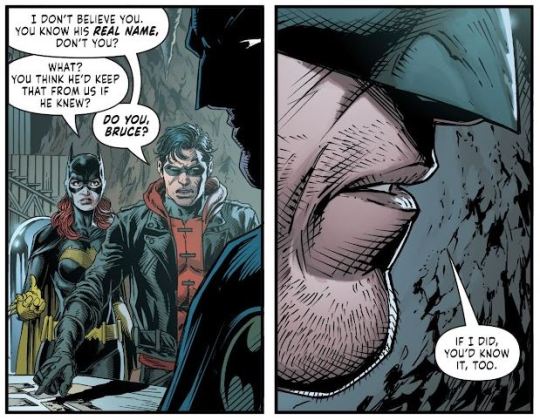
🎶 Why the fuck you lyin'? 🎶
Finally they get the alert that Joe Chill was kidnapped, and on investigating his cell, Bruce finds a bunch of letters addressed to… himself, Bruce Wayne. He seeks out the prison reverend.

Which is unintentionally hilarious, because in the storyline that started this whole three Jokers nonsense, there's a Batman Darkseid War one-shot where Joe Chill's behavior does not remotely align with this.

Lol comics are fun.
In the middle of Bruce investigating the letters, we get Jason being all repentant with Babs again.

You just said? You totally were?? Gonna kill more clowns??? How is this supposed to come off as genuine? Granted, Jason doesn't try to kill the other Jokers after this, but the apparently impetus for reversing course is... uh... we'll get there.
Anyway, among Chill's letters are tickets to the Monarch Theater, so the heroes all head over for whatever the Jokers have set up for them, which of course includes another horde of failed Joker zombies. During the fight, the Comedian's interview of Joe Chill plays on the screen, and the Criminal reveals they have Chill tied up in a chair suspended over a vat of green chemicals.
As Chill on screen explains that he killed the Waynes out of hatred and envy for how much they had, and how much he regrets his actions, the Criminal explains that he considered both Jason and Barbara as strong candidates for the new Joker. And wait. WAIT. Mr. Johns, sir, are you telling me it crossed your mind to write a story in which Barbara becomes the new Joker? That's so much more interesting than the bullshit we're getting! Imagine it: Barbara dealing with the dissatisfaction of being the "good, strong victim" and just losing her shit. You could combine that with how uneasy Jason is with his similarities to Joker, and maybe Jason is the one who convinces Barbara to turn back. This is Black Label! This could've been anything! Anything!
But we've got Chill. And the Criminal goes on to say the reason he wanted to make a new Joker at all:
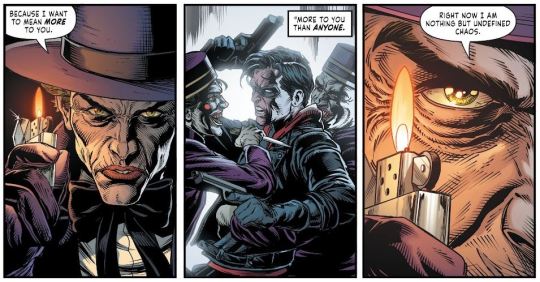
Are… are you? I'm pretty sure Joker is pretty well fucking defined. He's a murderer with a very dark sense of humor who is obsessed with Batman. That's been a pretty good through-line.
Also, Joker pretty clearly means a lot to Batman, as that middle panel with Jason seems intended to remind us, but the Criminal does clarify that he wants to be "everything" to him, which is why he's pulling Bruce's parents' murderer into all this. I guess I can't blame him for reaching for the stars?
Cue big fight scene. The Chill recording continues to explain his regret, and soon the theater is on fire. Batman saves Chill and knocks the Criminal unconscious. Chill thinks Batman is going to kill him, but Bruce saves him from a falling brick wall instead— before the Criminal revives and tries to set off a bomb to kill them all, maybe. There's a BOOM flag sticking out of the dynamite a few panels later, after the Comedian shows up and shoots the Criminal in the head. TWIST!
The Comedian surrenders, and after a scene with Jason picking the most awkward time to suggest he and Barbara try being a couple and Barbara looking pissed she has to tell him no, we jump to Bruce and the Comedian in the armored police car.
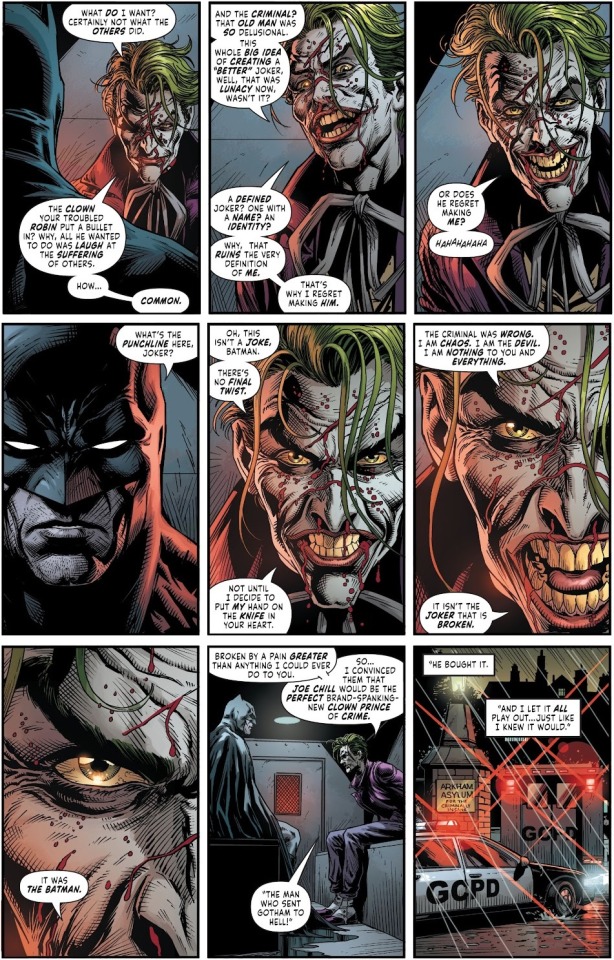

As a batjokes shipper, looking at these pages is weird, because they are good food for the brainworms. The Criminal wanted to engineer a Joker who meant the most to Batman, but the Comedian wanted to be that Joker. It's a weird plan, considering that Joker prefers Batman over Bruce Wayne, so he would be more likely to not want to heal Bruce's wound lest the healing lead to less Batmanning, but still. This crazy plan is all about maintaining Batman's attention.
But I can only enjoy these panels out of context, not just because I'm pretty weary of insanely elaborate plans that manage to work out, but also because there's just so much to hate in the rest of the story, especially the real twist that closes it out.
Before we get to that, though, we're thrown back into the Jason/Barbara nonsense with a very gross letter he writes to her.
"Dear Barbara, I want to make a change. But I can't do that without you. I know I've come across cold and distant…"

1) Look, love can help people heal. Barbara could be a good friend advising Jason on what might help him. She could help bring him back into the batfam fold. This letter is not that. This letter is pushing someone to be in a romantic relationship with you for the explicit purpose of getting them to heal you. That's not how love works. That's using someone as a tool. It's supposed to be sad that Barbara never sees the letter but it's good, actually. Don't put that shit on her!
2) This romance came out of freaking nowhere and now we get Jason insisting he can simply stop being Red Hood for the sake of it— but only for the sake of it, apparently! Does Jason think his worldview as Red Hood is an impediment to healing or not? This is just surface-level melodramatic nonsense. And I wish that was the point, but no. Again, the letter getting swept away is presented as sad.
3) Speaking of which, who tapes a confessional letter that exposes your vigilante identity to a door where anyone can see it? You'd slip it under the door at least. Johns couldn't figure out any other way for the letter to vanish? Get out of here with this contrived nonsense. There should've been panels of Jason rereading the letter, realizing how unhinged it is, and throwing it away himself.
4) Is the "Funtime Cleaners" guy in his purple uniform supposed to be Joker? Or representative of Joker's influence on their lives? If yes and it's him, he's a goddamn hero. If it's symbolic, what does that mean, that even when you reach out to others… elements out of your control will keep you alone? 'Cause that sure is bleak for a book allegedly about healing.
With all that done with, now we get to the big twist, the dumbest fucking part of this story, the end, the takeaway. Of course it involves more crimes against The Killing Joke, which I'm increasingly convinced no one at DC has actually read in the past thirty years.
Bruce drives up to Alaska, and we get this reveal.
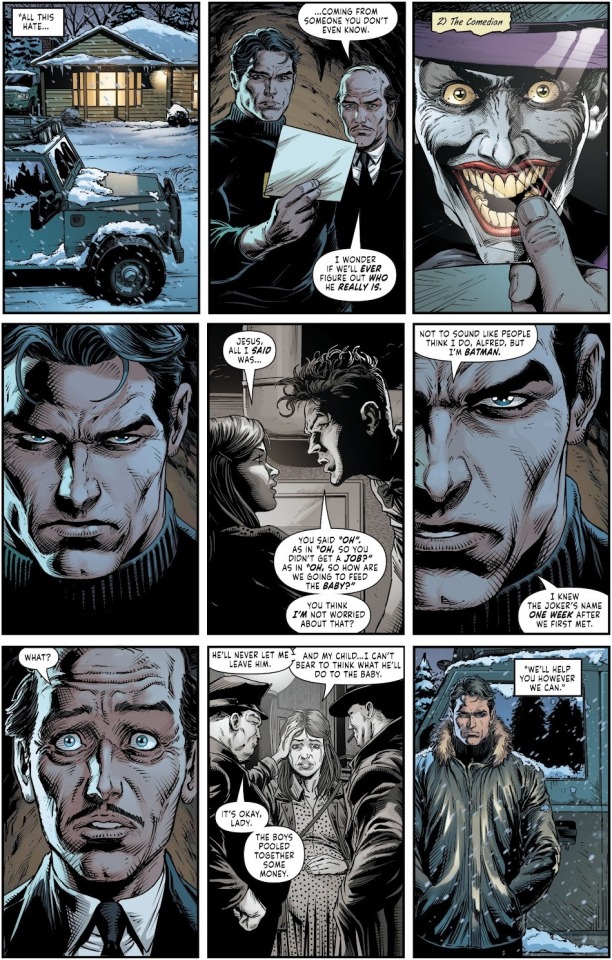

Do the kids still *headdesk* nowadays? That's what I'm doing. There will be a blood stain.
1) So Bruce has known the Joker's identity, or at least the Comedian's, basically the whole time. We're just retconning that the Joker question he asked the Magic Chair wasn't for information; it was a second test question. And all this is in the face of Bruce lamenting many times over the years that he doesn't know who Joker really is, of him lamenting it in The Killing goddamn Joke. "I don't know him, Alfred. All these years and I don't know who he is any more than he knows who I am. How can two people hate so much without knowing each other?" We're just. Fucking excising that. A line alluding to Bruce's motivation for visiting Joker in TKJ's opening scene.
2) We're rounding out the lazy revisions to the TKJ backstory with some copaganda! Geoff Johns doesn't think it's possible for Joker to have been anything but a horror to his family, but he does think it's possible that random officers in the friggin' Gotham City Police Department— in early Batman lore no less, when they were at their most corrupt— would fundraise for a "lady" they clearly don't know to get her out of the city to safety. Also, what was the plan for when Joker asked to see his wife's dead body?? Congrats, you've come up with something dumber than "Pushback."
3) This scrawls more highlighter on how bad the premise of there being three Jokers is, because the flashback in TKJ happens before Joker starts out. Like that's how Bruce always recalls it; he didn't meet the Joker until after what happened at Ace Chemicals. So isn't Jeannie then actually the Criminal's wife? Because the Criminal is the one who behaves as Bruce remembers Joker was at the start. So is the Comedian obsessed with the Criminal's wife for some reason? Or is the Comedian actually the first Joker, and the Criminal came later and used to be more wacky? What is going on here?
Under all these questions, per the final page, the point of Three Jokers is still visible: ultimately, his victims matter more than he does. But that's a hilarious point to a story that revolves around three of the guy, with very little payoff to the gimmick, and when part of the plot is that the heroes still shouldn't kill him.
And again, just because a story makes reference to healing, it doesn't mean it's "about" healing. The most we get is the knowledge that Barbara and Jeannie received support from other people. There's no discussion of how long it took either of them, of why Barbara came out the other side not wanting to kill Joker, of anything Jeannie has done since she left Gotham. The possibility that Jason could find connection is promptly throttled by a forced romance. It's implied that the Comedian's plan worked for Bruce, as we see Bruce at Chill's deathbed, holding his hand, and at Chill's grave. You might be interested in Bruce's thoughts as he juxtaposes Chill's repentance against the fact that his parents are still dead, so you can assess if this really would affect the feeling of loss that drove him to his lifelong mission, but you won't get them. The "how" of healing is up to the reader— who is never asked to extend the same thought process to the Joker. And you personally do not have to give a crap about Joker, but again, if this book is supposed to be about responses to healing, about Jason's response versus Barbara's, then taking an actual look at Joker feels relevant!
So there we are: fourteen pages of me venting my little heart out, hoping the premise of Three Jokers never gets looped into canon. I'm well aware that my personal attachment to a character means nothing against DC's incentives to promote stories with Big Twists (and endless events and multiverse bullshit), but then again, those incentives are based on what people will buy. So if I can add to the voices saying that Three Jokers is bad, and you should not spend your money on it or books like it, maybe I can be one vibe of many that keeps the Joker as one single bat-obsessed murderclown...
Though if not, I can always retreat to older comics. I still have plenty of those to get through.
#three jokers#the killing joke#batjokes#batman#joker#bruce wayne#barbara gordon#jason todd#analysis#my jibber-jabber#tl;dr three jokers is just usual batman stuff with a dumb gimmick#and jaybabs thrown in for the lulz
140 notes
·
View notes
Text
matteru
I was searching through my scrivener project yesterday because someone asked me how many WIPs I had and so I became very distracted looking through the insane mess and found this little bit I wrote for an AU I wrote with Sammy where Valentine and VS were both alive in the 2020s– this is the one where Valentine was dying from radiation poisoning and agreed to get Soulkilled and sort of ends up in a whole Smasher-esque situation working at Arasaka and then gets blamed for Saburo's death for political reasons. Anyway! I enjoyed this little Valentine/Goro snippet so I'm sharing it here (~2k words total)

It had been decades since Valentine had been in Night City, but very little had changed, except for the smell. The new smell wasn’t any better than the old one, but it was different in a way that she found difficult to pin down. Some new sort of metallic-earthiness, courtesy of an updated chemical cocktail being pumped into the air. God only knew what kind of new cancer was en vogue. Her own killer had been gamma radiation– her DNA had simply unraveled and that had been the end.
[He’s not going to show.] Johnny flickered into view by Valentine’s elbow, leaning back against the same railing she was looking over. She hadn’t seen him since earlier in the morning. He’d been busy chewing through the processing power and storage she’d allotted him in sullen silence. [We should get out of here.]
[He’ll come,] she said, placidly.
She wished in vain for her hard frame, locked away somewhere in the belly of the Kujira. It was bad enough to be labeled a traitor and hunted like a dog, but to be stuck in this soft borg doll when it happened was almost too much to bear. To be certain, it would have been impossible for her to pass through NC unseen in her frame, seven feet tall and emblazoned with the Arasaka logo in striking black and gold– but her synth skin was feeling uncomfortably fragile just now, chilled and clammy in the humid night air.
[How do you know he’s not going to turn you in?” Johnny asked. He sounded bored. She could feel his restlessness like something slithering through the cords of her thigh muscle.
[Why are you so sure he is?] She shifted her weight from one leg to the other, and the drone on her shoulder gripped a little tighter. When she’d arrived in the city two nights ago she’d had eight functioning drones, but all that was left was little Phiddipus Rex– a fist-sized array of cameras on legs, its face turned towards the city behind her, as it watched for movement in the darkness.
[Every corpo has just one thing on their mind: themselves.] Johnny tapped at his forehead for emphasis.
[And yet I can’t seem to get you off my mind.]
[Gonna get us fucking both killed,] Johnny muttered, shaking his arms out as he glitched in and out of view. [Just because you can’t handle getting cut loose.]
It wasn’t a matter of wanting to be back at Arasaka, but it was pointless to argue with Johnny about the realities of her existence. He was nervous and he hated being in this body almost as much as she did. She couldn’t do much about the latter, but since they were stuck here waiting she might as well see if she could get him to stop feeling sorry for himself.
[You’re worried I’m gonna sell you out,] she said, placidly. [I told you I wouldn’t.]
[Great,] he snapped. [I feel much better.]
[You’re welcome.]
Despite the surge of spite from his corner of her brain, he did eventually relax. He wasn’t doing too badly, considering how recently he’d woken up. No one had prepared him for life after death. She wanted to be angry at him, for killing her, but she had other things to worry about and the collapse of Arasaka tower had been a long time ago. No use in holding a grudge against a man as dead as she was.
While she may have been staring out at the choppy, black water of the canal, her attention was on Rex’s cameras, so she noticed the first signs of movement before the automated alert could zip its way up her spine. She’d expected to see the lights of a car in the tunnel, but instead someone was quietly and dropping down the side of the concrete wall that led up to the street above. Only one figure– she recognized his height and gait immediately. Takemura.
For close to a decade they had played the same game: she had spread her net of drones and cameras across the Arasaka compound and he had tried to walk through them without being detected or detained before he reached the room where their master slept. That game was over. Saburo had met his death on his own two feet, far away from home and their well-tested safety net.
For the first time, she wondered if he was coming to kill her. He could never believe she had done it, of course, but he had loved Saburo the way only an Arasaka child soldier could, and he was loyal. Grief could make anyone unpredictable.
[Eyes up,] Johnny said, mistaking her calm for obliviousness. She ignored him, and let Takemura get closer. He would be able to see Rex on her shoulder, and know she was watching.
He stopped a few meters away, falling into a parade rest, attentive but not hostile. “Higurashi-san. I apologize for being late…I was busy with other matters.”
The nickname made her smile, despite herself. He wouldn’t have used it if he were here to kill her. But Johnny was nervous again, curled tense in her muscles. [What’s he saying?]
“I’m glad you came,” she said to Takemura, in English. “I know it’s a risk.”
“You did not kill Arasaka-sama,” Takemura said resolutely, switching to the same language. He walked to join her at the railing, stepping into Johnny, who glitched and then fizzled out of view. “And you were not involved in any plan to do so. Of this I am certain.”
Valentine turned her head to look down at him through her own eyes. He was shorter than she was, though he didn’t take it personally as some of the other soldiers did. She knew him well enough to read his face in profile and see that he was sincere. But she was unprepared for the feeling of relief that accompanied the realization, like she’d let out a breath she’d been holding all day.
“Thank you,” she said, abruptly turning back to stare at the dark water. The gesture was not neatly done. He knew her well enough to recognize her discomfort and weakness, but it was too late to undo.
Rex still watched out over her back. Their backs. But she could hear Takemura turning to look at her, as his voice met her and not the waters of the canal. “Did you learn anything from the mercenary you found?”
“She was only there for the relic,” she answered, automatically. The question had been an order, and Takemura presided over all matters related to Saburo’s security. Even now. “Both she and her fixer insisted it. They were terrified and arguing before I interrupted them, so I doubt they were lying. Neither she nor her partner killed him.”
“Then who?”
She couldn’t bring herself to say his name. “You know as well as I do.”
“He has ordered your capture,” Takemura said, with the same reluctance. When she didn’t respond he added, “You must lie low. Do you have somewhere–“
“Yes,” she interrupted. “I’ve found someplace safe.”
The last thing she needed was her competence questioned. She’d survived Arasaka for longer than Takemura had been alive, on her own wit. She’d killed all of the soldiers they’d sent after her in that shitty motel. Just because she needed his help for a few things didn’t make her helpless.
“Of course,” Takemura said, a little stiffly. “It is a pity the mercenary did not survive…her testimony may have been useful. We must find some other proof to take to Hanako-sama, to clear your name, and bring Saburo-sama’s killer to justice.”
Valentine met his gaze and held it. “So you’ll help me?”
He nodded. “You would do the same for me, were our situations reversed.”
“I would,” she admitted.
Johnny glitched into view behind Takemura’s shoulders, arms crossed and rolling his eyes. It took considerable effort for her to ignore him, although it was difficult to look directly at Takemura’s face when he was so full of sincerity. It wasn’t that she didn’t appreciate it, but she couldn’t quite trust it. She wasn’t a person, she was a tool, and occasionally a weapon. Everyone else understood that.
“I went to the motel,” Takemura was saying, drawing her attention back to the present. “The damage was extensive…I am glad to see that you are unhurt.”
A guttural laugh escaped from her chest before she could stop it. This body made it harder for her to control her impulses. Made it too easy to forget what she was. “Lost my drones.”
That was the whole point of the drones, of her. Arasaka wasn’t afraid to throw bodies at problems, but drones were easily replaced, and they didn’t require decades of investment and implants and psychological evaluation. Or so the presentations her handlers and research team said, when they were asked to justify the cost of her continued existence and the project responsible for her creation. But none of that mattered when the emperor’s son committed patricide, and there would be no replacing the drones that functioned as her eyes and ears and hands outside this soft-shelled prison. Rex was all she had left.
“I am sorry,” Takemura said, quietly. He opened his jacket and pulled something from one of the interior pockets. “I thought you might wish to have this. Some of the black boxes were destroyed, but the others have been retrieved.”
“Which ones were destroyed?” she asked distantly, taking the piece of warped, armored carapace from his hand. It was only a small piece– easy to hide, she guessed, and she didn’t know what to think about the fact that he’d taken it. The outside was scored and pitted, but the inside was mostly untouched, and the luminescent paint she’d used still glowed from light exposure. The fractal design she’d painted there, meant to be visible only to herself during maintenance, was now cracked open and exposed. The Sierpiński triangles meant this was a piece of Sphecius. Sphecius, whose heavy armor had finally broken guarding her from a blow meant to crush her rib cage.
“I cannot be certain,” Takemura replied, apologetically.
“It’s alright,” she said, absently, tracing one of the triangles with her thumb. She would have taken the black boxes themselves, but once the drones were damaged badly enough they started broadcasting a signal to make them easier to find. There was a very similar box tucked up on the inside of her heavily armored breastbone, nestled between her hearts. “Thank you.”
The thanks felt inadequate in English, too trite and insincere. But she was aware again, of Johnny, watching through her eyes. Judging her reactions. He wasn’t the first to watch through her eyes, take note of what she did, measuring her thoughts and reactions. She wasn’t going to give him any further ammunition, even if it meant cheating Takemura of the thanks he truly deserved.
#cyberpunk 2077#cyberpunk 2077 fic#my fic#johnny silverhand#goro takemura#heart-thief valentine#au: art isn't real
7 notes
·
View notes
Text
"Essential Reading"
"We are Robin (2015) #1-12 written by Lee Bermejo, art by Khary Randolph
Robin War (2016) written by Various Writers, art by Various Artists
Dark Days: The Forge (2017) #1 & The Casting (2017) #1 written by Scott Snyder and James Tynion IV art by Jim Lee, Andy Kubert, and John Romita Jr.
Batman and The Signal (2018) #1-3 story by Scott Snyder, written by Tony Patrick, art by Cully Hamner
Immortal Men (2018) #1-6 written by James Tynion IV, art by Ryan Benjamin & Jim Lee
Batman & the Outsiders (2019) #1-17 written by Bryan Edward Hill, art by Dexter Soy & Veronica Gandini
Dark Nights: Death Metal - Robin King (2020) #1 [the back-up] written by Tony Patrick art by Danial Sampere
Tales from The Dark Multiverse: METAL (2020) #1 written by Jackson Lanzing and Collin Kelly art by Karl Mostert
The Next Batman (2021) #1 & #3 written by Brandon Thomas art by Sumit Kumar
Batman: Urban Legends (2021) #8 & #9 written by Brandon Thomas art by Cian Tormey
Batman: Urban Legends (2022) #18 & #19 written by Brandon Thomas art by Alberto Jimenez Alburquerque"
17 notes
·
View notes
Text

dickbabs post-rebirth reading list
*note - not all of these issues feature dickbabs together, some are just laments about the current situation of their relationship or them working as a team!
current ongoings
nightwing (2016-): issue #3, #10, #15, #44-47, #50-51, #54, #57-58, #68, #72-75, #77-; annual #1, annual #2, annual 2021, annual 2022, annual 2024
detective comics (2016-): issue #1047-1051, #1053-1058
batman (2016-): issue #99, #127-129, #136-138, #145-146, #148
batman: the brave and the bold (2023-): issue #4, #13
titans (2023-): issue #1-2, #6-7
catwoman (2018-): issue #45
former ongoings
batgirl (2016-2020): issue #7, #9, #14-17, #25, #27-28, #39, #44, #50
batgirls (2021-2022): issue #2-3, #7-8, #19, #12
batman: urban legends (2021-2023): issue #2, #6, #9, #22-23
the flash (2016-2023): issue #787
superman: son of kal-el (2021-2022): issue #10
limited series
dc vs vampires (2021-2022): issue #2-8, #10, #12
dark crisis on infinite earths (2022): issue #3
titans: beast world: issue #1-6
the boy wonder (2024): issue #1
event tie-ins
dc vs vampires: hunters: issue #1
titans: beast world tour - gotham: issue #1
knight terrors: nightwing: issue #1-2
anthology issues
dark nights: death metal - the last stories of the dc universe: issue #1
dc's how to lose a guy gardner in 10 days: issue #1
#it's done!!!!!#hopefully it is good lmao#aside from their solos#i don't really remember instances of them being together prior to 2020#when they officially start dating again#but i could be wrong!#so let me know if i am#this really does take you through the slow burn though#if you click on it the link at the top takes you to a locg reading list#if you prefer it organized better that way#but it's not as clean as it is in this post#barbara gordon#dick grayson#dickbabs#dickbabs reading list#dc comics
34 notes
·
View notes
Text



Death Metal Harley Quinn by Khary Randolph Dark Nights: Death Metal Guidebook (2020)
#harley quinn#comicedit#dcedit#dc comics#harleen quinzel#khary randolph#dark nights death metal#dc#comicsedit#dcmultiverse#dcladies#comicswomen#comics#my edit#buzz cut harley my beloved
72 notes
·
View notes
Text
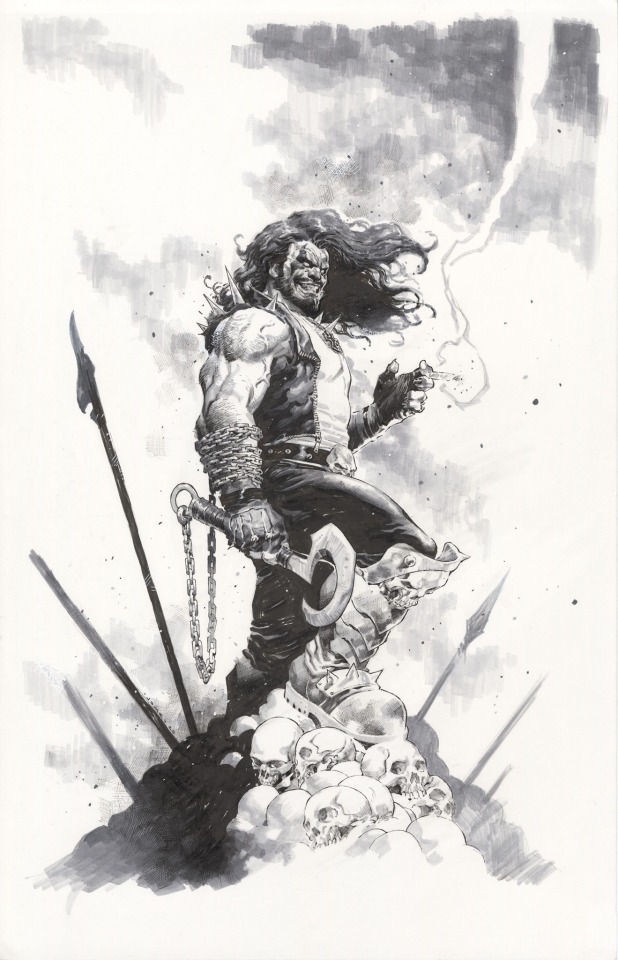
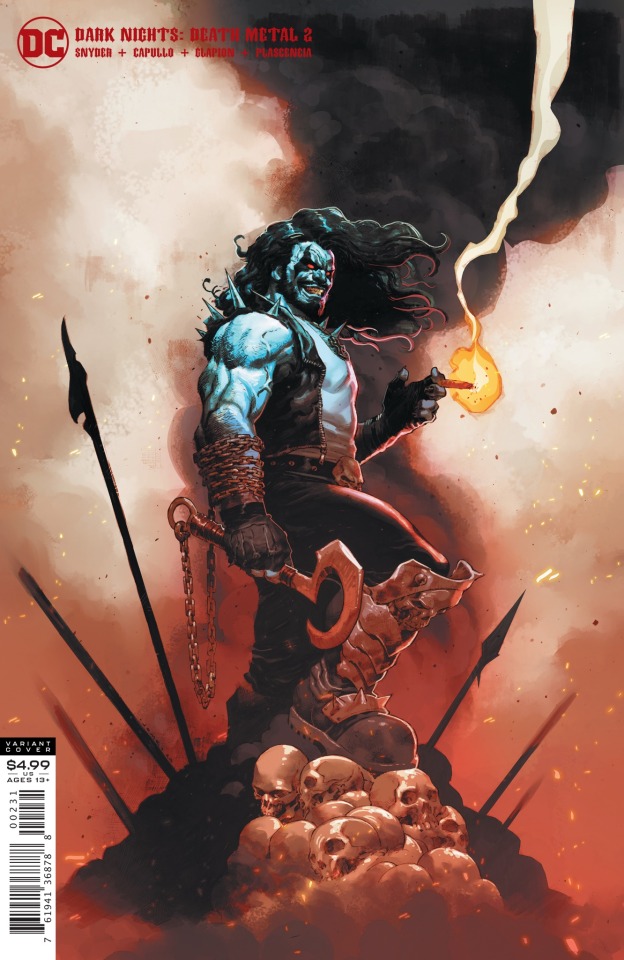
Jerome Opeña - Dark Nights: Death Metal #2 (2020) Lobo
Source
50 notes
·
View notes
Text

Horrorstör
Author: Grady Hendrix
First published: 2014
Rating: ★★★★☆
I don´t really dip my toes into horror often, because I am a scared baby. But much like Hendrix´s My Best Friend's Exorcism this one was very readable, quick and with imagery disturbing enough to entertain me without the risk of me not being able to go to the loo a night. Might look at some big stores differently from now on though.
Silas Marner
Author: George Eliot
First published: 1861
Rating: ★★★★★
A perfect classic for any classic beginner! It has everything I love about Victorian literature. Family secrets, dirtbag relatives, treachery and redemption, the question of class and money... and it is all presented in a compact and easy-to-read short volume.
The Phone Box at the Edge of the World
Author: Laura Imai Messina
First published: 2020
Rating: ★★★★☆
A beautiful book about grief and coping with the death of those we love the most. What matters in it more than the plot itself is the meditation upon that painful subject and the many various forms it can take, as well as the suggestion of possible ways of finding the strength to go on.
Moonstone
Author: Laura Purcell
First published: 2024
Rating: ★★★☆☆
Something about this book felt very "classical" as if it had actually been written at least a hundred (or more) years ago. Laura Purcell has shown her metal as a writer and storyteller before and this, her latest offering, is not at all bad. Yet her decision to venture into the YA genre was unnecessary, stripping the story of the darkness it could have had. My problem was that very early on any reader can tell what the big mystery is and it takes way too long for the main character to come to the right conclusion. Fine but fairly predictable is the verdict.
Rozpůlený dům
Author: Alice Horáčková
First published: 2022
Rating: ★★☆☆☆
To nejsilnější, co kniha nabízí, je téma.: sudetská rodina, částečně německá, částečně česká, v tragickém období první poloviny 20. století. Bohužel tato rodina nikdy v knize nepůsobí jako rodina a na počátku je stejně tak hrozná a dysfunkční jako na konci. Jediná z postav není sympatická, což samo o sobě by nemělo být tak důležité, ale přeci jen bych čekala, že budu s někým soucítit a soucit se vůbec nedostavil. Kniha nenabízí nijak zvláštní zápletky ani zamyšlení, natož prozkoumání bolavého a dodnes kontroverzního tématu. A co především: toto není krásná literatura, ale zkušebně psaný filmový scénář. 80% textu jsou úsečné dialogy, rychle se střídající scény navíc vůbec nadávají možnost zastavit se, zamyslet, zůstat s nějakým pocitem. V módě je zjevně syrovost a "styl ledovce", ovšem ani jedno ani druhé jsem nikdy ve svých knihách ráda neměla. Rozpůlený dům si už našel své nadšené čtenáře, já se bez obav se svým názorem vydávám proti populárnímu proudu.
Ordinary Wonder Tales
Author: Emily Urquhart
First published: 2022
Rating: ★★★☆☆
I suppose the biggest hurdle for me was the fact that I had hoped these would be essays about folklore, instead, they are mostly personal recollections to which the author then draws some basic folkloric parallels. Quite well-written and definitely very intimate.
The Misadventures of an Amateur Naturalist
Author: Ceinwen Langley
First published: 2021
Rating: ★★★☆☆
A romantic and soft retelling of a famous fairy tale, a sapphic one at that too! I quite enjoyed it, though I thought it took too much time to get moving and consisted mainly of endless talking in the second half. But not bad at all.
Lessons in Chemistry
Author: Bonnie Garmus
First published: 2022
Rating: ★★★★★
A book any woman should read to remember you can be anything you want. And that we should never forget there were times we couldn´t. The tone of the book seems light throughout even when it deals with some sad, even tragic events. It is extremely easy to fall in love with the characters.
The Honey Witch
Author: Sydney J. Shields
First published: 2024
Rating: ★★★☆☆
The first half of this book is really just vibes and man, was I happily vibing. The honey, the bees, the woods, the meadows... I was eating that shit up. Then we left the cosy magic for some romance and I was OK with it for the most part, though it lacked the previous enchantment for me. But then it went all topsy turvy near the end when SPOILER the horny lesbians masturbate together only for one of them to die from it (yes, you have read that right) so we call on the magical bees who collectively sting the dead girl back to life. END OF SPOILER The action near the finale was the weakest part of the book and the ending left me unsatisfied. I am giving this book VERY generous 3 stars because I genuinely enjoyed half of it (and even that, admittedly, had some minor issues).
Carrie Soto is Back
Author: Taylor Jenkins Reid
First published: 2022
Rating: ★★☆☆☆
Everything I enjoyed or loved with Evelyn, Daisy and Malibu is gone. No twists, no surprises and frankly no literary goodness as to the use of language. Character development happens in the last 10 pages. The book is predictable and really boring in its repetitiveness. It got to the point that I would skip all of the tournament descriptions and only read how they ended because I could not care less. Blows my mind this one is so popular because I find it mediocre at best. I did finish it so I guess that´s something.
The Poppy War
Author: R.F. Kuang
First published: 2018
Rating: ★★★★★
Please point me in the direction of the nearest bench on which I can sit down and scream into the void over this book.
Matrix
Author: Lauren Groff
First published: 2021
Rating: ★★★★☆
This is what I call an interesting book. The author plays with language in a way that feels very intimate but still holds a certain detachment. She has chosen a supremely fascinating woman about whom we in fact know next to nothing. The book is a fictional biography of sorts, but rather than a biography of a person it captures the existence, the growth and trials of a community of women. One of those books you fall into as if through a suddenly opened window.
3 notes
·
View notes
Text
Daily Riddler 5/5
Dark Nights; Death metal (2020-2021) The riddler (with long hair!)

23 notes
·
View notes
Text
Nightwish's Floor Jansen: "Life is short. Time is not endless"
Floor Jansen opens up on her battle with breast cancer, going solo and what we can expect from the next Nightwish album

It’s Friday April 22, 2022 at Nokia Arena in Tampere, Finland. Fifteen thousand Nightwish fans await a much-delayed live taste of their heroes’ ninth album, Human. :II: Nature., released as the world shut down in 2020. Anticipation is high. The stage will soon be engulfed in enough fire to obliterate a small village. Aside from a handful of dates in Finland in 2021, this is Nightwish’s first full-scale show in more than three years.
Backstage, Floor Jansen feels like death. In her stage armour she looks fearsome – a tattooed Boudica for the modern age. Such a gig wouldn’t normally faze her. Floor, 41,has been fronting metal bands since she was 16. But just now she’s come down with a virulent stomach flu at the worst possible time, and she’s wondering how the hell she’ll get through the next two hours onstage.
“It was unlike anything I’ve ever done,” she says of the stomach flu that almost derailed that post-Covid comeback. “I mean, you get sick now and then, but this was brutal. I don’t know what kind of virus I picked up, but it was a very violent one. I was up all night, and then I still had to travel from Berlin to Tampere. It was horrible.” She shrugs. “But yeah, what can you do?”
It’s not hard to see why Floor gets called a ‘powerhouse’. Part opera singer, several parts rock star – with the dynamism of both – she exudes indestructibility. If Bruce Dickinson had a daughter with Xena: Warrior Princess, it would have been Floor. But there are other sides to her: different personas that reveal a more complex, interesting picture of a ‘powerhouse’ lead singer.
There’s the animal-loving homebody. The thrillseeker. The proud vegetarian. The whiskey drinker. The metal icon with a solo pop album on the way. The Highly Sensitive Person, whose hyper-stimulated sense of the world shines through her performances. The person who, just three weeks before headlining Wembley Arena with Nightwish, underwent surgery for breast cancer.
“I’m always myself,” she summarises, simply. “So whether I run around in jeans fixing a fence, or ride my horse, or go onstage in warrior outfits… it’s all the same. It’s just a different side, as you can see.”
We meet Floor over Zoom in December, as she wrestles with dodgy wi-fi backstage in Milan. “Is it noisy for you, in the background?” she asks in perturbed Dutch tones. “It’s basically one big open box here…” Dark-eyed and slightly frazzled in a grey hoodie, Floor has a business-like streak that softens as talk turns to things like her solo music, her bandmates and the cigars she enjoys with her husband, Sabaton drummer Hannes Van Dahl.
On another day she might have come in from feeding the horses at her rural property on Sweden’s west coast. You wouldn’t fuck with her, but you’d gladly go for a drink with her. Out on the road with Nightwish, there’s a decent amount of the latter. The band “wobble” around Christmas markets drinking glühwein. They rate vegetarian food in Indian restaurants as part of a longstanding curry club. The shows themselves have been jubilant affairs.
“Last night we were surprised with some bottles of champagne,” she grins, “which we then drank, and became very happy…”
It’s all so far removed from lingering notions of Nightwish as some sort of dictatorship or soap opera, with singers driven away by its founder’s maniacal demands. They seem like friends – as in, actual friends.
“It’s absolute genuine fun,” she nods. “We’ve always had that. And there are always ups and downs; it’s like a big marriage. But we’ve been longing for this tour a lot. Especially after the pandemic, we don’t take it for granted at all.”
For Floor, the isolation of lockdown reinforced her ties to the band, but it also kickstarted her solo work. She’d begun to think of it in 2019, following an appearance on Dutch TV show Beste Zangers (‘Best Singers’), but she was still very much a band person, with a new Nightwish album cycle around the corner. Come March 2020, for the first time in her career, she found herself separated from that group mentality.
She spent time with her husband and daughter, now five. She grew vegetables and looked after her horses, cats and enormous Irish wolfhound. She worked on her online profile, communicating with her fans on a regular, down-to-earth level. At the same time, she began working with collaborators on solo material. An alternative, poppier sound started to brew.
In spring 2022 she appeared on Germany’s Beste Zangers equivalent, Sing Meinen Song, for which she sang in German (one of the four languages she speaks in addition to Dutch, English and Swedish). Gradually, a standalone Floor Jansen was evolving.
“My desire from the get-go was to find a sound that fits with me, not something created around me. But how do you do that? So I used up a large part of the pandemic in a trial-and-error search for this sound.”
It wasn’t easy. Ten years of bringing Tuomas Holopainen’s visions to life had left her with phenomenal vocal skills, but limited songwriting practice. Her first ideas, she says, “weren’t that great”.
“I’ve done it [songwriting], but I haven’t been doing much in the last 10 years,” she admits. “Plus I’m in a band with someone like Tuomas. It makes me feel very small, like, ‘What do I have to add to a world full of music?’ So from that insecurity I had to find my way and accept that I am more limited, and that I have different ideas.”
Teaming up with Dutch producer Gordon Groothedde (Snoop Dogg; Katie Melua; Floor’s previous band, After Forever) was a turning point. The first song they wrote together was Fire. A darkly atmospheric, orchestral swirl of intelligent modern pop, with the grandeur of Florence & The Machine’s cover of 1986 dance hit You’ve Got The Love, it ignited Floor’s confidence as a creator in her own right.
“I have a really hard time with love songs,” she says. “I know the majority of pop music is about love songs, and that’s also why I find it boring to listen to. So I wanted to create something that still has a message.”
Accordingly, her solo album, Paragon, shuns frothy clichés in favour of meatier subjects. Fire is about returning to life after lockdown. One song, Invincible, was written for the injured war veterans at Prince Harry’s Invictus Games – originally planned to take place in 2020 in the Hague until the pandemic got in the way.
“It’s inspired by the idea of being physically or mentally wounded, after you’ve just given everything you have,” she explains, “and something that’s left of you has to pick up life, and recover from something that you never really wanted to recover from. I want to raise awareness of the fact that this happens so incredibly often, but also to empower them. Like, ‘You already went through Hell, now you’re on your way back, you are invincible.’”

It’s hard to hear this story now without thinking of Floor’s recent health issues. Diagnosed in October 2022 at a routine mammogram screening, her breast cancer came as a total shock – two weeks before Nightwish were due to fly to South America.
“They [the doctors] said, ‘We want you to come back.’ And the thing I thought, in my naïve brain, was, ‘Oh, they fucked up something with the pictures.’ Never, ‘Oh, they found something.’” She shakes her head. “Not a single moment. Until I was there.”
Surgery was planned for the day after they came home. Until then, she says, the intense business of touring Brazil, Argentina, Chile and Mexico proved a good distraction. The pace of it all was brutal but helpful, and reading similar stories from her fans made her feel less alone – “But at the same time, it’s an overwhelming awareness of how many people actually got this fucking disease."
“I put my emotions into the music,” she reasons, “and also had really wonderful conversations within the band, crew, management, everyone has really been there for me. It’s very tough to do it all that fast, but at the same time it helped because I didn’t have to walk around with thoughts of it too long. Because as soon as you know you have a tumour in your body, the only thing you can think of is ‘get it out’. The whole mental aspect of a cancer diagnosis is shit.”
Back at home, she had three weeks after her operation before heading out in Europe and the UK. Scarred, bruised and exhausted, she was grateful for the support of her family.
“Jesus, how I underestimated it,” she half-laughs, of the recovery process. “I was jet-lagged, I barely slept for nights after the surgery because my system was completely upside-down, you get morphine… So everyone’s been really having my back in this.”
Just a couple of days before the Wembley gig, she learned that the operation was successful. It was both a relief and a wake-up call. In Sweden, mammogram screenings start for women at the age of 40. In the Netherlands, her birthplace –and in the UK – it’s 50. Now looked up to by many, as a public figure as well as a musician, she’s determined to persuade more women to go for their scans.
“On a purely personal level it’s a bit weird, because I’m just me,” she says, of her role-model status. “But from this position, I have the power to make a difference every now and then. I wanted to make sure it has this function by saying, ‘Go and get your mammogram done.’ If I had stayed in the Netherlands, this entire thing would have gone undetected. It was so small when they took it out, but it was growing, you know? I’m very lucky.”
Cancer casts a pervasive shadow, even when it’s caught quickly. For Floor, who (when we speak to her) still has three weeks of radiation therapy to complete, it’s realigned her priorities. “It’s not like I think ‘I’m gonna die’ all the time,” she explains, “but I realise how life is short. Time is not endless. We have it now.”
To that end, Floor is making the most of 2023. After her radiotherapy is finally over, she’ll join Nightwish for 70000Tons Of Metal in the Bahamas. Festival shows will follow. In the summer the band will head to the Röskö campsite in Kitee, Finland, to record the next Nightwish album (which will be released at some point in 2024).
Part three of a trilogy that began with Endless Forms Most Beautiful and continued through Human. :II: Nature., the new album will return to themes concerning our planet and our mortality. Sonically, Floor suggests, we can expect aheavy palette.
“I would say it’s a pretty heavy album,” she muses, “but once again, it’s the multicolour diversity that is Nightwish. It’s all there. It’s going to once again take you by the hand through beautiful stories – whether they are stories from this Earth or stories about this Earth. They’re beautiful.”
Creatively, Nightwish is still Tuomas’s brainchild, though there’s a sense of collaboration around this record. Armed with his demos, the band have been working up different parts and exchanging ideas on tour – in hotel rooms and dressing rooms across the world. For Floor, this has been a happy arrangement.
“I think Tuomas has a unique view on the world and has a unique way of putting that into words,” she says, “and I think he’s outdone himself on that end once again. And also visually, the ideas that are bubbling are going to be of a next level. So yeah, there’s lots to look forward to.”
Meanwhile, along with the release of Paragon, she has solo gigs planned in Europe. “And of course it would be wonderful to go to the UK,” she adds, “we are working on that as well.”
If all goes to plan, Floor Jansen could be a name that reaches well beyond metal circles – paving the way for a new kind of pop star with a darker heart. Once again the ‘powerhouse’ label feels apt, with all the truths and misconceptions that come with it.
“Power is often connected to, especially women…” she searches for the words, “…it’s like, ‘powerful women are bitches’, you know? Maybe that’s the misconception of the century. But a powerful woman is also a woman who is intouch withher emotions, and one who can have absolute soft sides and embrace them. The idea that high sensitivity would be a weakness? That is actually the absolute misperception.
“And that goes for men, too: for men to be in touch with their feelings and to be able to communicate them… that is a bigger strength than [makes growling, macho noise]. That’s going to bring us a whole lot further.”
Between travels, Floor will recharge at home in the Swedish countryside. On cold evenings, she and Hannes sometimes retreat to their grillhouse, light the fire and relax over single malts and a cigar – things that bonded them when they first met on tour with Iced Earth. Small connections between worlds.
“I can say that my happiest place is home, but that’s not true because after half a year I’ll claw up the walls,” she laughs. “I can say it’s on tour, but after a month I really want to go home. I can say it’s onstage, but then putting my daughter to bed is equally amazing at times. The ultimate thing is to have the luxury of both.”
22 notes
·
View notes